#which has always been PART of the main issues but using that as the crux and lens through which a solution will be acheived is a stretch
Text
I rlly liked red hood the hill bc besides the gift it completely ignored everything else with the batfam which to meeee I’m taking it as the hill has been overlooked by the bats forever (see Orpheus rising) so yeah nobody there gives a fuck about those people and jason knows better than to bring that shit over there
#genuinely tho#I dislike the trend rn of simplifying Jason and Bruce’s issues and making it seem like Bruce was nice and accepting all along and Jason just#needs to get with the program#like the fanficication of that and the Damian Bruce issues or Damian tim issues or even Dick and bruce issues#where everything comes down to the kids being insecure and Bruce being bad at communicating#which has always been PART of the main issues but using that as the crux and lens through which a solution will be acheived is a stretch#a stretch only made in fix it fics that is picked up by ppl who dont read shit and then writers who dont read dont care and get a check#THIS IS MY ISSUE WITH WHERE IT SEEMS BATFAM IS GOING THAT IS NOT AN ISSUE I HAVE WITH RE#NOT ABOUT RED HOOD THE HILL#back to red hood the hill#i DO like them#playing off how jason has always been able to relax there#with a community that has eachothers back#and the flip from#his early red hood days to seeing dana go that path is soooo#what i find interesting tho as that he positions himself as support and backup more than a deterrant#like yes he does try to talk her down a lot but most of the time hes living his life with a worried eye on her#and i think it shows to how he reacted to ppl (bruce) being heavy handed with him#and u know i love the batfam repeating awful cycles shit i think its very interesting that this is one jason didnt repeat#maybe bc hes so close to the feeling or that dana isnt to him what he was to bruce or even that hes just relaxing and thinking clearly and#above all trusts her#most toxic fun future would be for her to break that trust and him to go crazy but thats a diff rant#anyways my entire summary for jasons character is that THAT is what good coochie does to a nigga#carmen thank you for your service another crazy off the street 🙏🏾#red hood and the hill#oh. still no Orpheus mention#no it doesn’t hurt less anytime 💔#Jason Todd
7 notes
·
View notes
Text
not to salt openly on main or anything but instead of playing up a grown adult man's ineptitude to the point where he doesn't even know how to search for the nearest children's hospital on google or recognize food in the refrigerator, they could have instead utilized the part where he tries to give miri cold medicine for adults as a visual metaphor for the fact that she has completely different needs from the two of them; it's all fine and well to be miri's video game buddy until the moment where you have to step up to be the adult in the room, which... really should have been the crux of rei's character arc imo?
rei's stunted development has always been more of an emotional issue--sure, he doesn't take care of his body all that well either, but the real impact of his upbringing is that he doesn't know how to relate to others in a more responsible manner, because he's never been put in that position before. his deal is that he "doesn't know what love is", including self-love, and love here also encompasses the capacity to care properly for others. kazuki wasn't only doing the physical housework, but also bearing the brunt of the emotional work that goes into keeping a child on-schedule and out of danger, which rei had to deal with for the first time while alone with a sick miri. instead we get about a grand total of about 2 minutes of screentime on the kind of internal turmoil this caused him ("i can't do anything...") and exactly zero minutes on the effort that he had to expend in kazuki's absence while miri needed him--all we get is the final shot of him asleep that only implies some of the work. he's not even the one who presumably takes her to hospital! what was the point of having kazuki out of the picture on his little grief journey, if not to show us the development of rei in real time?! kazuki doesn't even come home to a clean house!!!
i think my irritation with ep 7 stems mostly from the inability of the writing to address the (usually very gendered) inequality of housework and emotional load distribution within a household in any cogent or meaningful fashion, instead using it as the vehicle to explore kazuki's backstory and cut in a few comical scenes of rei in distress instead of actually taking the issue as seriously as it could have. kazuki didn't just leave the house bc he was sick of daily life, he was grieving and being devalued in his household while a 4 year-old and a 25 year-old manchild roommate were constantly testing his patience. i was really, really looking forward to some kind of significant emotional reckoning on rei's part that we got to see onscreen, one that was more consistent with his character (he was NOT this helpless before, even in ep 1 before he met miri) and that would actually mean a little more for the plot than.... honestly whatever we got in ep 7.
also, just on a personal note, as a former (and sadly ongoing) rei stan, it's not very cute to watch a grown man flounder around his own fucking house not knowing how to call a cab or fry a single egg. it's not sexy. it doesn't serve. bring back the sexy rei suwa right now or i'll storm the fucking studio with a torch.
#rambles#buddy daddies#negative#sorry. this rant was sitting in my stomach like a stone so i had to excise it like a bezoar
42 notes
·
View notes
Text
Been sitting in my head for a long time so let's unpack all my thoughts on the song Me And My Husband by Mitski and amatonormativity
First things first this isn't a plain and simple love song, it irks me that so many people hear this and think its a story about a lovely ideal long term relationship.
The song starts with a sigh, let's begin there. Before we even get into the lyrics we meet our narrator and hear her sigh, tired and laboured.
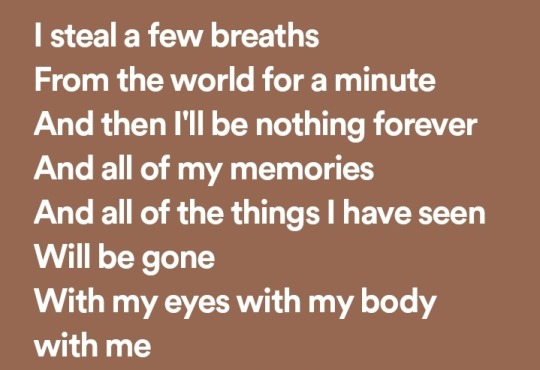
The first verse can be summed up with our narrator talking about the shortness of life and the great length of death that proceeds it. I steal a few breaths for a minute could be a metaphor for how we are only alive and breathing for such an ultimately short amount of time, and then I'll be nothing forever..., until we die and everything we are will be gone.
I think that this first line could also clue us into the fact that the narrator is a position she finds tiring; she sighs, steals a breath to catch herself and returns to her relationship (since the songs main focus is her relationship) and once she returns feels like she is nothing. From this point of view it would mean that the narrator has a shaky sense of self, that in her relationship she is not her own person.

The line we're doing better obviously implies that at one point their relationship wasn't doing very well. Some people take this to mean that the relationship was toxic or abusive, but to me it could also represent the natural stagnation that a long term relationship can often lead to. We've all heard of the honeymoon phase in the first stages of a romance but for most, the longer you stay with a person the dimmer that spark gets, since it's always just been just me and him together I wouldn't be surprised if their relationship began to grow stale.
A furrowed brow is a strange thing to use to describe someone you love, especially since it's really the only descriptor of the narrators husband we get in the song. Many people think that the furrowed brow indicates that the husband was often angry or had anger issues, which perhaps was the cause of their relationship turning south.
But despite her husbands supposed anger issues, the narrator is adamantly betting all she has on him. It makes sense since people who do go on to get married do so within the mindset that the person they marry will be the one and only romantic partner they'll have until they die. She has literally bet the rest of her life, all her love of this furrowed browed man.

I don't know if there is a deeper meaning to these lines but to me it's a reference to the traditional marriage rows of "til death do us part"

This is where the theme of amatonormativity kicks in. This verse gives us insight to our narrators low self esteem; she sees herself as an idiot, a waste of space, a clown. But her husband makes her feel loved. Remember though that the only descriptor we are given of the husband is his infamous furrowed brow, he is less of a person and more of a placeholder. Not "Tim the love of my life who does xyz to comfort me and makes me feel loved because he loves me", but rather "Husband Character who makes me feel I am worthy of love". The lyrics isn't that she feels loved, it's that she is loved. Like it's an undeniable fact that because she had a husband she must be loved.
This is the crux of amatonormativity. Its the societal belief that a person is happiest or can only be happy if they are in a serious romantic relationship. It frames those who are single as being broken or unworthy of love. It's the mindset that makes people choose to stay in a bad or unfulfilling relationship because the alternative is assumed to be the worst outcome regardless of how untrue that may be.

The least dark interpretation of this song, and the one I agree with most, is that the narrator, an unconfidant person with low self esteem, finds herself in a long term relationship that simply isn't fulfilling to her and she's trying to make it work. Maybe it didmaybe it didnt and never will but at this point she doesn't care. She's been with this man for so long, she's poured so much time and love into this relationship that she might as well stick it out until the end. Besides, life is only so short it be over and gone before she knows it. She doesn't necessarily need to leave although it sounds like she'd be happier if she did, but mostly she's afraid to leave because what would she be without this relationship? She has a weak sense of self and thinks lowly of herself, at least with the presence of her husband as proof she knows that she is worthy of love.
Another popular interpretation is that the narrator is in a toxic or abusive relationship. Her husband has anger issues but she stuck with him and tried to make things work claiming that they're now better whether or not that's true.
In both cases the theme of amatonormativity stands firm. Me And My Husband isn't a plain love song. It's a story about a woman who for her own happiness should end her relationship but ultimately doesn't because its easier, because life is short and she might as well just stick with it, because society has conditioned her to belive that being married and settling down surely means that you're worthy of love
37 notes
·
View notes
Text
Edit 04/16/2024:
Putting all this here because I don't feel like making a whole post for this by itself & would rather have it somewhere that those who are actually looking for it can easily find it!
I've been hemming & hawwing about rewriting BLP for months now (if you've followed me through my bitching I commend you) & finally decided that in order for me to be truly proud & invested in what I was working on, I needed to refocus on a lot of things.
First, I haven't really written any new content for BLP in...months. I've just been trying to rework what I had and getting increasingly unhappy with it because I felt that since I had dedicated so much time to these ideas, they should be used. This lead me to realize that the entire fic needed reworking in small and major ways. I definitely see myself using a lot of what I've written here for the rewrite, just recontextualizing it and connecting it in more substantial ways to the major themes I want to hit on. Which was another issue.
I thought I had a major theme/throughline for the fic. I did not. Or rather, I did and it got very, very clumsy. Part of this comes from the fact that I did the bare minimum outlining because I was so excited to write & share what I was making. Things sort of started to get away from me & I was treating each chapter sort of as a one shot in itself so they were all sort of disconnected in a way that I was never happy with but felt too far into to do anything about. The clumsy handling of supposed major themes also came from what I identified as my main issue: I wasn't writing the fic I wanted to be writing.
In recent months I realized I was holding back. There were certain scenes, kinds of relationships, and graphic/violent themes I wanted to write about that I was scared about being received poorly despite the setting of Fallout being host to all sorts of dark & taboo things. Because of this I would shoot down my ideas as I was writing & subsequently became displeased with what I was making because I wasn't really getting to the crux of what I really wanted to write. Like ghosting around it in a way that coming back to the fic now, basically a whole year later, did not jive with me.
There's also the matter of Georgia developing a lot more in my head than what I was writing down. It's like every time I would strike out an old idea I could feel her over my shoulder in a "you're butchering me, you're butchering my character arc!" way lmfao. Writing BLP has taught me a lot about my own OC, which is kind of wild. This was Proto-Georgia. Pilot Georgia. First Draft Georgia.
Despite it all though, BLP has helped me a lot in terms of writing improvement! It's also helped me find lots of cool people in the fandom with amazing OCs and fics of their own. So for that, I probably won't delete this version of BLP for now, if only so it serves as a reminder of where I started!
I thank everyone who read, reblogged, commented, & kudos'd my fic. It truly means the world to me that literally anyone was interested in my silly little oc & my take on her silly little merc. Mwah <3 Off to the rewrite!

Fandom: Fallout 4
Ship: Female Sole Survivor/RJ MacCready
Characters: Canon Divergent Sole Survivor, RJ MacCready, Preston Garvey, Piper Wright, Nick Valentine, Original Characters
List of Triggers: Self-harm, unhealthy coping mechanisms, unhealthy/abusive relationships, mentions of child death, (to be updated as they appear)
Summary: Georgia Tate has always had a plan. She planned to be a teacher, eventually a wife, and perhaps a mother. In the 2070s, she has a pretty good idea of how her life should turn out. But after she's thrust into a future where her old world ideals don't make sense anymore, she's determined to make the best of it. She's willing to fight for a safer world for her missing son to live in, once she finds him.
RJ MacCready has always known what life is like in the wasteland. He knew just what it was like to be a leader, a mercenary, a father. To be a leader, you had to be tough, to be a mercenary, you had to be quick, and to be a father, you had to be there. So when a woman walks into the Third Rail calling herself the new General of the Minutemen with more caps than sense, MacCready thinks he might actually be able to pull of the job that brought him to the Commonwealth in the first place.
What neither of them are prepared for is the Commonwealth getting turned upside down with Georgia at the epicenter, much less for making sense of the feelings steadily growing between them. But even with Georgia's boundless optimism and MacCready's endless realism, best laid plans can often go awry...
Table of Contents
Chapter One: Maybe I'll Say Maybe (Rewritten 01/20/2024; original)
Chapter Two: Crawl Out Through the Fallout
Chapter Three: Hit the Road, Jack
Chapter Four: Accentuate the Positive
Chapter Five: Dear Hearts and Gentle People
Chapter Six: I've Got a Feeling I'm Falling
Chapter Seven: Dream a Little Dream of Me
Chapter Eight: Rhythm of the Rain
Chapter Nine: I Get Along Without You Very Well
Chapter Ten: So Much to Do and So Little Time
Chapter Eleven: Just In Time
Chapter Twelve: Into Each Life Some Rain Must Fall
Chapter Thirteen: It's All in the Game
5 notes
·
View notes
Note
hi again! i'm back with more thoughts as promised (nearly a month late but oh well)
just wanna start off by saying that i really appreciate your comprehensive response, as well as the other posts that you linked!! i feel like the point that i keep coming back to, the one that really hit the nail on the head and explained the crux of the issue is this-
it feels like every argument “for” Mike and El staying together is made by people so used to celebrating mediocre writing that they’re at a loss to process what’s happening when writing its done well and with intention
-this part in particular is why we're hit with the 'delusional' accusations so often. stranger things is a mainstream show, and mainstream shows are usually not made with the level of care and concern put into ST, especially when it comes to queer characters and storylines. like i said before, people are used to being spoonfed with in-your-face queer media and when it doesn't happen i see it being chalked up to simple 'bad writing' - or in the case of will's s4 storyline - a supposed complete lack of respect for these characters.
i have seen so many people express disappointment that will did not get a coming out scene in season 4, and didn't actually use the word gay, so much so that noah schnapp himself felt the need to comment on somebody's tiktok about how will was still so young and would get to have his moment once he was ready (which, not to get parasocial or make assumptions, but that must have been so frustrating for him to hear repeatedly while being in the closet himself). these mainstream fans are jumping to conclusions and assuming that will not coming out in season four means that the duffers are homophobes and don't have any respect for queer people.
never mind that they've had this in their pitch before this show was even made. never mind that they've been intentionally pulling out this storyline since season one and that "it's been their vision for a long time." never mind that they've said over and over that will is going to be a central point of season five and that his sexuality arc will continue into the final season. because he couldn't come out in s4, the duffers must be homophobes, right?
and this also goes hand in hand with the whole painting situation. people who believe that ST is just another mainstream show genuinely and honestly think that it will never be brought up again, despite the main catchphrase of the show being 'friends don't lie.' they really think that the painting has served its purpose, and that the duffers aren't "smart" enough to bring will's elaborate lie up again. they think that we've left the storyline there, with will giving up his sad unrequited feelings for mlvn's sake and that nothing could ever come from this. lots of people, even those rooting for byler, have been burned over and over again by bad writing and are pessimistic to the point where they don't want to believe that anything good could ever happen for fear of being hurt again.
but that is just the folks who do want byler to happen - when it comes to byler antis, even the reddit bros who recognize that ST has more effort put into it than most shows still use this excuse of 'it's a mainstream show, they're never going to do that' as a reason to why byler is impossible because they're just so used to mainstream media catering to the mostly cishet audience since that's the way it's always happened. they cannot fathom the idea that this show is different and isn't for them, despite all of the evidence screaming otherwise.
and their refusal to “sink to their audience level” in that way means people who are just heteronormative and might not mean any real harm by it are intentionally left in the cold.
not just because it means people miss fairly straightforward subtext, but because they haven’t even been taught that subtlety is a thing you can do
this is 100% true as well. i think in most GA cases, the lack of belief in byler endgame isn't even malicious, it's just that like you said, they were never taught to look deeper and analyze media critically (that, or they were watching ST while also being on their phone half the time and thus missing all the subtext). these are the kind of people who wouldn't be mad about byler happening, but would probably be left a little confused because the heteronormative goggles are so thick that they'd never even considered byler as a possibility. but hey, the upside of this is that s5 will inevitably boost the rewatchability of the show so that people can go back and find the clues they previously missed and marvel at the fact that their favorite piece of mainstream media gave them a narrative that was this clever.
also, i think i've mentioned this before, but it's interesting to note that my ten-year-old sister was able to pick up on byler endgame immediately. when we watched vol 2 together in august, she took one look at the final shot and said to me, "so, will and mike are getting together next season, right?" and as she's someone who hates mike, she complained to me for a good hour or so about having to watch will end up with him next season. she's not in the fandom and was obviously not someone who was looking for clues about byler endgame - in fact she's someone who strongly disliked the idea of them together - and yet she was still able to see it. to her, it was obvious, and i think it's because she's so young that she hasn't had time to be burdened by heteronormative society yet. for her generation, mike choosing between el and will is no different from nancy choosing between steve and jonathan, and so she's free from the blinders that most of the audience is still shackled with and is able to pick up on the subtextual clues far more easily.
(oh, and she's come around about byler since then because apparently mike is "more tolerable" to her when he's around will.)
anyway, i hope this jumble of thoughts made some semblance of sense to you. i, for one, am very much looking forward to the "curtain is blue" + the heteronormative crowd to be blown away next season and for ST to set a precedent of higher quality show-not-tell stories, both in terms of queer media and just general storytelling, that will be followed up on for years and years to come ✌🏼
(no pressure about responding to this ask btw!! i know it was really long and you probably have a lot of other asks and posts to get to before then ahah)
this is a 12/10 response—I don't even want to give any notes lmao
I think it really is that special mix of heteronormativity / homophobia combined with media illiteracy and just...a lot of bad TV that makes it hard for a lot of people to fathom that Stranger Things is going to do something several shows have failed at historically: namely, writing not one, but two different queer individuals with 5 seasons of independent purpose and depth before getting them together, and with the same respect for their romance as a slow-burn straight story (while showing, not telling). I do see us slowly getting better told stories that honor queer people in movies, but...shows have been a lot slower, particularly mainstream ones / ones that don't specifically cater to queer audiences, especially in the US.
Since your first ask we've gotten The Last of Us Episode 3 reminding us that yeah, people can write deeply satisfying queer stories into shows that aren't necessarily queer—and without officially labeling the character's sexuality before they get together—but the radical fact that people have grown with Mike and Will for nearly a decade only to watch them fall in love (in a way true to their individual arcs) will be revolutionary in a lot of ways.
The binge model Netflix has worked with since ST dropped has made people less aware of the fact that its a better written show than most of the ones they've watched, you're right—and people the world over who only watched it casually will flock to watch it (or watch it over) once they realize what The Duffers have done. I will respect Matt & Ross forever for committing to setting a better precedent for queer stories in mainstream media, once this story is done lmao.
Thanks for the ask! And feel free to send more! :)
#lmao rae I might have asks but I'm gonna answer this first for sure#everyone needs to read what you said LMAO#ice-sculptures#asks
5 notes
·
View notes
Text
TV Fanatic: 9-1-1 Season 5 Episode 7 Review: Ghost Stories
"[...] No matter how hard we may want to, those ghosts can stay with us long after we've presumed them to be long gone and buried. And that's what the crux of 9-1-1 Season 5 Episode 7 is all about, though it's an odd hour that decides to put secondary characters at the forefront, which doesn't work out the way it should have.
Listen, I have nothing against secondary characters. They are essential pieces to every show, and they help keep things fresh and move storylines forward. But there's an issue when they take the focus away from the main stars of the show.
And that's what happened here, with the main plot going to Ransone and Taylor, which is weird to write out and even weirder to watch.
Ransone is a great recurring character. He and Athena work well together, and there's no issue with him getting screen time. He and Athena do their detective thing and investigate the case because they're, you know, actual cops doing their jobs. But Taylor comes out of nowhere, suddenly wanting to be like a private investigator, turning Buck's dining room into a mock precinct, and nothing about it works.
For starters, since when is this what Taylor does? All we know about Taylor, for the most part, is that she's after a story. Being a reporter and all, that makes sense. But now she wants to get to the bottom of this mystery, for what? It's bizarre. And the longer the episode goes on, it just gets stranger. And the fact that she somehow was at the location of an active crime scene before Ransone was so dangerous, and again, didn't make a ton of sense.
Taylor is an okay character for what she is, but the show's insistence on making her a more significant part of an already bloated show doesn't sit right with me. We've got plenty of characters, literally, just begging for the kind of spotlight Taylor was afforded throughout this installment. She somehow played a more substantial role than Buck and Bobby combined. Where is this kind of spotlight for David? Or Karen?
Taylor has always been more than just a love interest, but in an episode that was already missing Maddie and Eddie, it felt weird to be getting this Taylor Kelly showcase. But this has been such a disappointing season thus far that it shouldn't have been all that surprising.
The big case she and Ransone were trying to solve started promisingly, but then it just got campy and confusing. And campy is fine, but it was hard to keep up with the back and forth montage of Ransone and Taylor trying to present the facts. And from there, it just got worse and worse, culminating in this nonsensical reasoning for a man to get buried alive, which is a shame because the premise was great, and the lead-up to finding Edgar was brilliant.
The first few minutes were classic 9-1-1, with the first responders deploying all their resources to rescue someone in tandem with the call center. And tense seconds of Buck listening for a man's scream from underneath the dirt was harrowing and everything you like about the show. But that was the highlight, as far as the rescues go.
Elsewhere, we got some more Karen finally, but I'm sorry, how many times are we going to go down this Eva road? Who even remembers Eva's exists until she's back and making things uncomfortable for Hen and Karen. At least, the couple seemed to be on the same page by the end, and this isn't something that will linger because it's a story that 9-1-1 should have put to bed a long time ago, especially since Hen never wavers on her decision to be with Karen and her family at this stage.
So, Eva coming back now didn't carry much emotional weight because it's a moot point now.
Odds and Ends:
* I've said this before, but sometimes they treat Eddie like background noise. And even having said that, it was highly noticeable he was MIA.
* Are they allergic to giving Bobby a storyline outside of being Athena's sounding board?
* All of these people are traumatized, but they seem to pick and choose who gets the space to deal with that trauma, and it's very baffling.
"Ghost Stories" was just not a great episode. There's no getting
around it.


#Not a good look Timmy !#911 spoilers#tv: 911#911: 05 x 07#press#jack.txt#EDITED with the correct link!
237 notes
·
View notes
Text
TogaChako - Good Girl and Bad Girl

Toga Himiko and Uraraka Ochako embody the classic good girl slash bad girl dynamic. It’s a classic dynamic in which one girl will represent what is the traditionally held notions of what a “good girl is” ie/ pure, nice, friendly and the other girl will embody the opposite of that a “bad girl” impure, mean, slutty. Inevitably, these two girls will fight. However, the crux of the good girl bad girl dynamic is that while the girls are total opposites on the outside, inside they’re the same, cuz they’re both girls after all.
Uraraka and Toga are written to be compared, they’re character foils, because the conclusion we’re supposed to come to isn’t one of them is good, one of them is bad, one of them is selfless, one is selfsh. Rather, they’re written so we see it’s the difference in circumstances that made them who they were. Toga became bad because bad things happened to her. Uraraka is good, because she was born into a good life. What makes a bad girl bad and what makes a good girl good? More under the cut.
1. Good Girl
Describe Uraraka Ochako. She’s a normal girl. She’s spunky. She puts other people first. She became a hero to help her parents make money, and feels bad because her motivations aren’t as selfless as say her close friend Izuku Midoriya’s. (But that’s wrong because she literally is being selfless, her reason for becoming a hero has entirely to do with benefitting someone else and not herself). She’s supportive, and friendly. She’s always cheerful and never lets herself get too down.
Uraraka represents the standard of a good girl in hero society. She’s always ready to help her friends, but ultimately she’s kind of passive. She works hard but is not too ambiitous. She’s selfless and always thinks of other people before herself. She has all of these good qualities.
However, I would argue Uraraka is a lot more complex then this. On the surface she seems to be just a good, nice girl who wants to help others, but her internal mechanisms are complex. While yes I agree Uraraka doesn’t have much of an arc so far due to lack of focus, there’s a difference between not having an arc and not being a complex character.
A simple character - what you see is what you get.
A complex character - Has internal mechanisms that show the surface isn’t as simple as you thought.
A simple arc - character moves through the plot without changing who they are.
A complex arc - character struggles in a way that fores them to change.
Uraraka’s inner mechanisms are complex in that there’s more too her in what we see at the surface, it’s just she hasn’t been challenged in any way. The plot doesn’t address her flaw and try to force her to change.
With that in mind let’s get into Uraraka’s character. Uraraka is defined to her goodness. Uraraka pushes herself to always be good to others. The reason being is that Uraraka is a very sensitive girl who is attune to the feelings of other people.
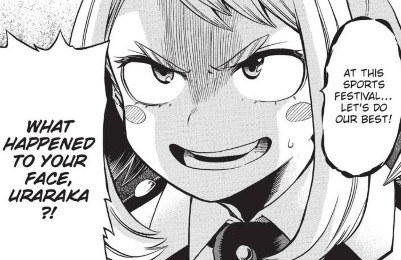
Uraraka gets serious for just a second, and people remark that she doesn’t seem like her normal self.
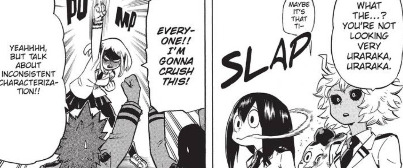
Uraraka then immediately backs up and gets embarrassed. She goes out of her way to beat herself up and denigrate herself in front of others, insisting her motivations are much more selfish than people like Ida and Deku.



Uraraka then tells Deku and Iida that she’s not becoming a hero for her own sake, but for someone else’s. Her entire motivation is to help both of her parents live easier lives, because she feels like she’s been a burden on them and pursuing her own dreams would be too selfish.


Uraraka is very secretive of her own feelings. She’s almost afraid to come off as selfish which is why she doesn’t share what her real goal is. Also, when she starts to get a little motivated to accomplish something for herself, everybody around her remarks how different this is from the fun-loving Uraraka they all know. Also, one last detail Uraraka never even talks about herself, and her friends don’t really think to ask, because Uraraka just so naturally makes things about others and not herself.

It’s already been elaborated why the reason Uraraka grew so perceptive. Uraraka’s parents were struggling to make ends meet and she grew up in poverty, and even if she has good parents that try really hard not to let the effect of this struggle show in front of her, Uraraka saw it anyway because kids are always watching their parents.

Uraraka learned to be sensitive to her parents needs, to never demand too much for her parents, her behaviors all became centered around not becoming a burden to others.
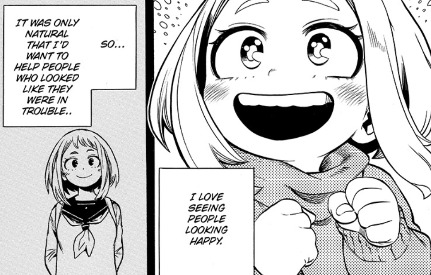
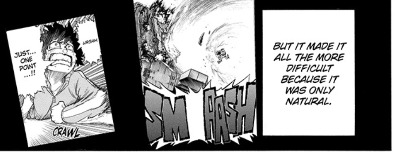
Uraraka thinks it’s only natural to put others first and help others before helping herself. That other people’s happiness is more important than her own. Because she’s someone naturally empathic. Because she’s someone naturally able to see the pain and struggle other people go through, because she grew up seeing it. However, the problem with this behavior is it makes Uraraka essentially a support to everyone else.

Uraraka is constantly putting others up on a pedestal and using that as an excuse to lower herself further and further. As cute as her admiration for Deku is, it’s also a bit unhealthy - as she uses it as an excuse to beat herself up. She sees Deku as this amazing person, whose always struggling to help everyone, whose always saving everyone for completely selfless reasons and she always suffers in the comparison.
I think part of Uraraka wants to stand out like Deku does, and has the same desire to go all out to save people, but Uraraka is so used to being secondary in her own life she can’t bring herself to.


Uraraka can’t even cry in front of others. I think, the most telling behavior she has in the entire series is the moment where she breaks down on the phone describing everything she did wrong because this is how Uraraka sees herself. She’s so extremely critical of herself, and constantly apologizing for herself, while at the same time hiding what she really feels from others.

Uraraka has all these self esteem issues that she basically just shelves so she can play the good, nice girl, that gets along well and is friends with everyone.
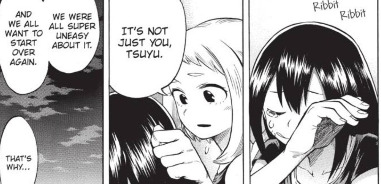
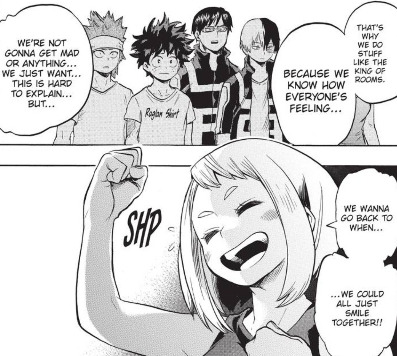
Uraraka assigns the role of group placater and peacemaker for herself because it’s something she’s so naturally good at and she’s always thinking of others, but because of that, Uraraka herself suffers. Uraraka only knows how to help people by belittling herself and her own role in things.
Uraraka’s greatest fear is being selfish. She doesn’t want to look like a bad girl. That’s the connection between Toga and Uraraka, because what Uraraka is afraid of ultimately is living her life the way Toga does.
2. Bad Girl
Toga is everything that Uraraka is afraid of being, and lives the life that Uraraka is afraid of living. Uraraka is someone so afraid of being selfish, and getting distracted that she is not even allowed to have a crush on a boy. Whereas, Toga lives her life chasing what she loves. Everything Uraraka represses about herself, Toga expresses. That’s the difference between the two of them.

When Uraraka first encounters Toga, her willingness to chase what she loves looks from Uraraka’s perspective to be entirely monstrous. Uraraka sees Toga as a selfish monster, because in part she is afraid of appearing that way.
Toga Himiko the bad girl.
However that’s far from the whole picture of Toga. When we see her away from Uraraka’s perspective she’s entirely different. She’s someone empathic, capable of being kind to others, and thinking about others feelings.

Toga’s just as capable of reading other people and addressing their feelings as Uraraka is. However, there’s still a key difference in their behavior. Uraraka acts to avoid conflict. When she intervenes, what she usually does is act in a way that avoids stepping on toes, and touts the “we should all get along and be friends’ line. Whereas, Toga is someone who directly addresses the conflict and the hurt feelings of others.
For Uraraka the most important thing is getting along with others. For Toga the most important thing is being true to her own emotions. Which is why she’s able to directly address the problem with Twice, she didn’t tell him to bear with it, she told him she knew he was in pain but that the two of them could take down the mafia together.
Even Himiko’s most selfish monster moments aren’t really that monstrous. Himiko’s reason for stalking both Uraraka and Deku is not because she’s weird and creepy, but because she wants to be a normal kid just like them.
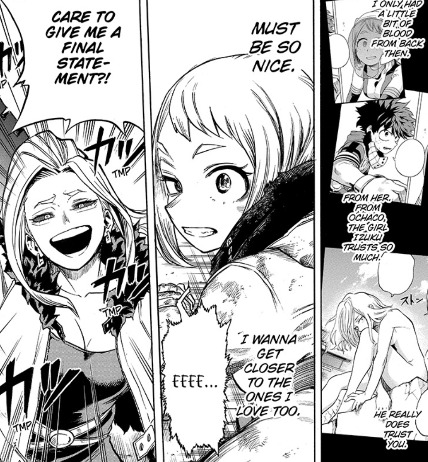
Himiko’s reason for sucking the blood of high school girls and taking on their appearances isn’t because she’s preadtory, it’s because she’s been a runaway with no home for two years and she’s terrified of getting caught.
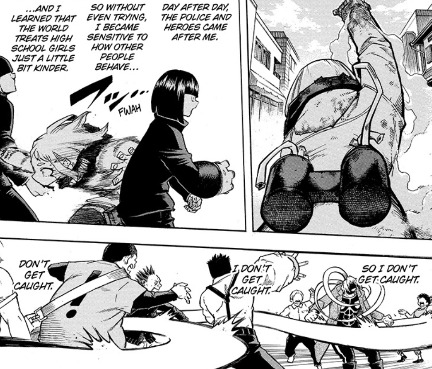
Himiko who is framed as a selfish monster, is actually quite the normal girl. She’s a normal girl reacting to the pressures of the society around her. The kicker is that Himiko isn’t someone who just decided to flip and turn out this way, she is only the way she is because she tried to live like Uraraka did at first.

Himiko tried to push everything down and live like a normal girl. She tried to lie about herself so she’d be a good, nice, harmless girl. She only became so selfish, because she tried to live selflessly first. She only prioritizes herself, because she was used to putting herself down before this. We see her classmates react to her, they all describe Himiko was the kind of girl that Uraraka is right now.

However, behaviors in Uraraka that are self-defeating and unhealthy, are absolutely ruinous in Himiko. Himiko has no sense of self, because she spent so long trying to be what others wanted her to be. Himiko is who she is, in reaction to the pressures of everyone around her.

When Himiko tries to figure herself out, she always gets the same response. Why do you have be so selfish? Why can’t you just act normal? Which completely ignores the fact that she TRIED and that’s what got her here.
The main difference between Uraraka and Toga is not one of them being good, and the other being bad. Toga’s been through way harsher life circumstances. Uraraka has parents that affirm her identity, and Toga’s parents deny her over and over again.

The point of the good girl bad girl dynamic is that they’re both girls in the end. Yes, Uraraka’s never reacted as badly as Himiko has. However, Uraraka’s also never been pushed so far. In fact someone as empathic as Uraraka can be oblivious to the suffering of others.
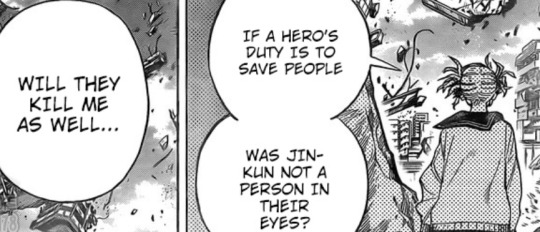

Uraraka doesn’t see what Himiko is going through, because she hasn’t suffered the way Himiko has.
It’s like.
When you have a good sibling and a bad sibling. The good sibling always behaves because they conform to the pressure their parents put on them. The bad sibling acts out in response to that pressure, and because of that their parents have to discipline them and they end up soaking up most of the parent’s attention. In that situation the good sibling can come to ressent the bad sibling for acting out and needing attention in the first place.
Reasonable child and unreasonable child. There exist these black and white categories to define children into where one looks good and one looks bad, that actually totally fail to address the child’s behavior because people are complex and therefore don’t fit into black and white categories. But, Uraraka is still working with that black and white logic when it comes to heroes and villains. Even though she’s usually so good at sussing out the complex nuance of other people’s feelings.
This is what’s happening here in this chapter. You can apply the dynamic between the two of them to the conflict at large. Toga is selfish for acting out and causing problems for others, because she wants her own personal grievances to be addressed. Uraraka is sefless because all she cares about right now is helping the most amount of people. Uraraka is willing to repress herself, and put others needs before her own, because what’s most important is everybody gets along.
However, Uraraka insinuates, the same way that Himiko’s parents once insinuated that Himiko’s acting out just makes her selfish.

We’ve seen this conflict before. Himiko literally went into the conflict to ask this question. Do problem children like her count as “everyone”. However, no matter what happens this arc, no matter what critcisisms the villains levvy against the heroes we get the same hollow repettition of “Heroes save everyone”. Which is why Himiko looks just about to snap here.
Uraraka who is used to brushing conflicts aside and avoiding them for the sake of “everyone gettling along” sees the girl who can’t get along with “everyone” and calls her selfish. To Himiko, this is the same words she’s been hearing her entire life. “Why are you making a fuss? Why can’t you just be normal.”
From one perspective, yes Uraraka is the one fighting seflessly because she’s just trying to save as many people as she can and Himiko is getting in the way of things. However, Himiko is someone who grasps the bigger picture. Himiko addresses the problem directly rather than sweeping it under the rug, there are people who aren’t saved by the hero system. Those people are just as in need of saving as what heroes deem to be innocent people. You can’t claim to save everyone and then ignore the suffering of people you deem as “bad”. Himiko seems like she’s acting selfishly, but then again she’s acting for the sake of people like Jin who died because heroes insisted that his life was less important.

Uraraka is at the same time very perceptive to the suffering of others, and also very oblivious, and it has much more to do with personal hangups than anything else. She doesn’t want to see Himiko as someone similiar to her, because Uraraka is someone so deathly afraid of coming off as selfish. To the point that she treats people with genuine grievances against society as selfish childrens making demands for atttention.
Uraraka is the one who can’t face herself, and therefore the answer she gives Himiko is to the effect of “Shut up and deal with it.” It’s a very personal thing for Uraraka once you realize that Uraraka has also been shutting herself up all this time, pushing herself down, always letting people walk all over. Uraraka is capable of putting herself aside for the sake of others, so as a result she sees people who can’t put themselves aside as selfish.
“I can do it, so why can’t you? Why can’t you be normal?”
I hammer down so hard on this point because there’s a difference between placating and conflict resolution.
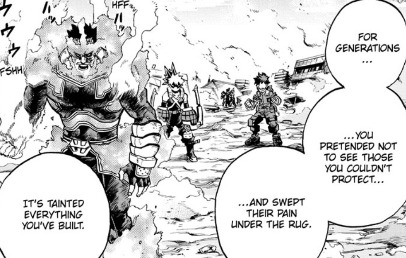
Placating comes from a place of “I want the conflict to go away” or “I want the hurt feelings to go away.” Placating is just saying whatever you think the person you’re talking to wants to hear in order to please them. It’s behavior that’s based entirely around avoiding conflict. Uraraka placates, she sweeps it under the rug, she swallows her grievances for the point of everyone happily getting along together.
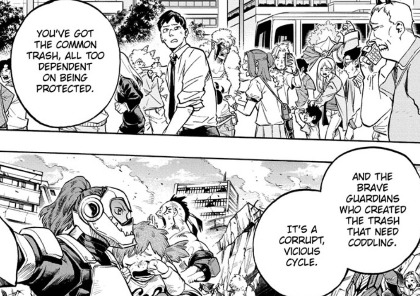
This placating also applies to the hero system at large. It’s not really designed to save everyone, so much as make the vast majority of people feel safe at the cost of the minority.
When there is a problem does Hero society directly address the issue? Or do they sweep it under the rug for the appearance of everyone getting along?
I think the fact that every time a villain brings up a problem this arc, the heroes just shout “Heros save everyone” and “Heroes never give up” is evidence of the latter. That’s why, when Uraraka says it, when Hawks says it, “Heroes save everyone” just comes off as hollow because in the very same breath they both make it clear that Toga and Twice are not part of the everyone who gets saved.
#himiko toga#uraraka ochako#mha meta#my hero academia meta#my hero academia#mha 288#mha 288 spoilers#bnha 288#bnha 288 spoilers#himiko#uraraka#ochaco#ochaco uraraka#toga himiko
1K notes
·
View notes
Note
I stopped watching SG years ago (due to lack of time not bc I didn't like it) but I have to ask - is Lena really becoming a witch? Are they going full Morgana again?
I've been enjoying SG a lot, anon! You should catch up if you have more time later.
Look. LOOK I am going to go on a tear here because like. Yes YES allegedly Lena is a witch do I know what that means NO all I know is that she went to Canada and a lady in a cave in Newfoundland was like LENA YOU LOOK EXACTLY LIKE YOUR DEAD MA YOU'VE GOT THE GIFT and the gift is apparently witchcraft.
(Except that she didn't say "ma" she said "mother" and I think this is my one main grievance vis a vis the Newfie accents in that episode but that's a different post.)
And this is very polarizing on the internet, because people - this may shock you - have opinions about this storyline, which are various. And look. This show has uhhh not very many episodes left the crux of this season WILL BE everyone finding the magic MacGuffins and making a Beebo together and also apparently starting a Jane Jacobs book club you can accept that or you can be mad forever, you know? Life goes on.
But I think the reason I'm so into it is - yes yes on the surface level it's objectively very funny and also Canada. But also it's actually a very interesting arc for Lena, and a neat way to give her a storyline that actually pushes her to work through a lot of the unresolved baggage from S5 on her own, without her driving motivation being Winning Kara's Affection or Kara's scenes being totally monopolized by her relationship with Lena. Because: look. The unresolved thing for Lena is and has always been her struggles with ego and hubris. She's very smart and that's never been in question, but its how she uses that intelligence and the ways that, when she's hurting, her emotions often push her to weaponize her intelligence and do really hurtful things. And last season was, in a lot of respects, a wake-up call to the fact that like - she's done harm before but it's never had consequences the way that the Hope/Non Nocere project had visible consequences. Which I think Lena needed to see to understand that she can sometimes be at real risk of hurting people she loves if she feels they've hurt her first and that's like - not great!
And magic is such a good trope for a character like that because the themes that go well with it are often the interplay between power and ego and self and control. Magic is science elevated to another level, and just like science a very clever person can do very real harm - even if they don't mean to - by inventing the wrong thing or giving a great invention to the wrong person. Which Lena in 6a coped with by just like. Divesting herself of LCorp and removing the temptation of Accidentally Getting Mad And Doing Evil Science, but that doesn't really address the root issue of like. Lots of people get mad and don't accidentally do evil science, you know?
(This is also nearly-beat for beat the Willow late-series throughline in Buffy and I'm going to make a million references about it ok I cannot be stopped.)
I'd argue that it's not "full Morgana," but in a lot of ways Morgana is the archetype that Lena is pushing herself not to be, you know? Morgana is a very hurt, very lonely girl who uses magic to hurt people who have wronged her right back, and there's a part of Lena that really could go there, always.
So what I love about this arc is that this is kind of baking that potential into her as a character. She has to think things through, because there's much greater risk that she could Accidentally Get Mad And Magic Murder A Guy To Death since it's a part of her! It's a way to give Lena the chance to learn for herself how to work with those parts of herself and be the good person she keeps trying to be and that's cool. That's so much cooler than just the surface-level trope of like. Floaty pencil magic book aesthetics and I want to dive into it a lot!
#maybe it's not just kara who is cookie dough#maybe lena is cookie dough even more#you know?#do i want to write the fic where lena just sort of wanders around fogo island learning coping strategies#probably not but also kind of#it's compliCATEd#do i want to write the fic where lena buys fogo island in a fit of pique#because the food isn't very good#and if she's going to learn to do magic she NEEDS to have a decent vegan power smoothie for breakfast#also sort of maybe#i contain multitudes etc#lena luthor: something something powerful magic#lena luthor: is the b'y that builds the boat#tagfic#my fic#supergirl spoilers#supergirl#cw dcu feelings
28 notes
·
View notes
Note
LITERALLY EXACTLY
also ppl who will scream about how dabi is ONLY a victim (not also an abuser now) and has done nothing wrong (Or is just expressing his pain or whatever bs i saw), are the loudest when it comes to hating endeavour, as if a man realising he was a cunt and is working on fixing himself and making it up to his family (who he understands can still hate him btwww) is to blame 100% for a grown man who decides to kill people rather than get help for his daddy issues. Like yeah dabis got trauma coming out his ass but blaming endeavour on his behaviour is ridiculous, man is in his 20's!! He can chose to not attempt to kill his own family (who are also victims of the same man LOL)
aND I would love to see more of overhaul, im a sucker for redemption arcs BUT I'd just love to see how he's handling things, he's such an interesting character, his dependance (is that the right word? He wants his dad lmfaoo) on pops even now is sooo interesting!! Like ppl will excuse shigaraki due to afo grooming him but not even blink at, yeah maybe a child growing up in the fucking yakuza wasn't good for him>
PREACH, ANON, I AGREE WITH ALL OF THIS 100%
Would you believe Dabi used to be one of my favourites? His rabid fans put me off him entirely. 🤧 Yes, he's traumatised, yes, his dad was absolutely awful, and I understand why he feels so betrayed and angry. But he's not just a victim, he's also a murderous psycho who'll burn everything and everyone in his path (including his own family) just to hurt his father. And you can't simply pin the blame on Enji and absolve Dabi of responsibility for his heinous crimes. That bears saying, same as Enji apologists ought to admit he effed up BAD and is the main reason Dabi came to be. But there aren't nearly as many Enji apologists as there are Dabi apologists, which is why I eventually stopped going into the Dabi tag around the time of the big reveal, when it was brimming with poor-little-Dabi posts and furious rants against Enji and against Hori for giving him a redemption arc.
Oh boy, I could talk about Chisaki for hours. I was one of the few who was absolutely certain he'd be brought back into the story, and I KNEW he would be desperate to fix his dad. I didn't foresee his mental health being as poor as it now, but it makes sense – he said it himself, he's got absolutely nothing left except Pops (...who isn't going to be too happy with him, if he ever wakes up...).
I've always found it annoying how most BNHA fans don't realise that the crux of Chisaki's character is his attachment to his father...most people make it out to be his supposed aversion to Quirks (which I think is just an expression of his own self-loathing, because actually, he only considers people as useful as their Quirks. He even NAMED HIMSELF and his two subordinates after their respective Quirks). Or his germaphobia, which is something he developed later in life – he was brawling with his schoolmates no problem as a kid, and we're shown a panel of what appears to be a teenaged Chisaki, shirtless, maskless and gloveless, who's clearly just used his Quirk in a physical fight and is staring at his hands, with someone's body parts splattered on the floor. No, what's always been there and really defines him is his devotion to his dad and his determination to protect his "family" at all costs. It's a twisted devotion ("Chisaki's warped compassion", Horikoshi calls it). I wonder though if the boss considered Chisaki his son in return? He never called him "Kai", only "Chisaki", which potentially adds a layer of insecurity to their relationship, on Kai's side.
I would love for Chisaki to get some amount of redemption and fully understand the pain he's caused Eri and his father. I think "Overhaul" is very clearly dead at this point, but Chisaki still hasn't really grasped the magnitude of what he did, and I hope he will at some point. I realise his dad (should he wake up) can't really be expected to forgive him... but I can't help hoping that he will 😣
Anyways, sorry for the essay, I'll shut up now. But thank you so much for piping up, Anon! 🥺♥️
50 notes
·
View notes
Note
I’d love your thoughts on BTS and their current image and music if you have them and aren’t afraid of the mindless internet hoards.
Personally, I liked a lot of their older stuff, but haven’t liked anything since I think the Fake Love promotions 3+ years ago. They’d started losing their personality and soul before that album cycle, but it feels like the sanitization of their image and artistry really kicked into hyperdrive after that. Now most of what they do seems like a sterile money grab driven by the Hybe hive mind which is a shame.
ok alrighty (cracks knuckles) let's get into it.
now that i've fully given myself a headache watching the majority of the bts videography, here are three points i'm going to cover:
performative character and the lack thereof
interesting aesthetics and the lack thereof, and
the inevitable cracking of perfection
ready, set, let's begin.
1.
idol music is very clearly definited by spectacle based aesthetics. and it's had that structure for its entire existence. so i gotta hand it to hybe for this one, because they managed to revolutionize being utterly fucking average. the triumph of bts is that they're just some guys and they look like just some guys. hybe found a niche in the system and then gamed that system to the tune of one of the largest musical acts in the world. they're not marketing bts as a romantic parasocial relationship, they're marketing them as your friends. and that is just as insidious to lonely kids as a run of the mill romantic fantasy. but that's not what i'm here to talk about today.
there's a pattern i find very interesting with bts mvs and that is that i don't remember anything about them. specifically, i don't remember the stuff that's happening IN the video; not the styling, not the setpieces, if i didn't know the members i doubt i would remember them either. what i DO remember, is how expensive the production is, and specific shots. i couldn't tell you what a single member was wearing, but i sure as hell remember that first upward angle shot of jungkook and the rusted park ride in spring day. or every single time they do that birdseye shot of jin in like every video. honestly as far as i'm aware jin has only ever worn a loose fitting beige longsleeve shirt.
it took bts a long time to establish any kind of consistent visual character. and the character they did establish.... i don't know if you can call a family-friendly-style clean aesthetic 'character'. they debuted as a hip hop group to little (comparative) success, and then made a switch to doing an early version of where they're currently at right now. if you've seen any of the mvs, you know that this is a pretty significant visual change. i don't think it is inherently a bad change, since the visual branding for hiphop based groups always tips over into iffy terrritory, but it is dramatic enough and early enough that it doesn't strike me as a natural evolution. concept switch ups are common, but they usually work because the members have established a bit of character for themselves, used their performance abilities and presence to fit into a niche in the group. the idol mould is perfect for showcasing the performers; that's its function. the groups that are the most fun to watch are the ones with stage presence, the ones who know how to perform, who can act all the parts they need to play. and bts? 4/7 actual performers on a good day. in my personal opinion it's 2/7.
i'm gonna expand on what i said about jimin here (this is technically the first part of this series), because it does apply to the rest of the group on the whole:
and i think here is where we see the main crux of the difference between taemin and jimin as performers: taemin has both an artistic and an idol persona. we know and understand him to do solo work that has a separate artistic meaning to just him being an idol. even though this performance was pre-move, i would still say this applies, because he's hot off press your number, where he's acting in a story based mv. jimin on the other hand just has his idol persona. he's not known for creating the same kind of storytelling that taemin is.
bts has been very insistent on the image of the group as a single unit. despite having the size of fanbase and the revenue that would make any official solo debut a massive success, none of them have done any substantial solo work. this isn't artistically a problem, and i think it's very admirable of them to be so dedicated to the image and the legacy of the group, when that can be an uncommon trait in the industry. i do however, think it starts to become an issue when we want to discuss what the artistic visions and images of groups are. shinee taemin and solo taemin have two distinct artistic representations, and taemin himself will attest to that. it's the same with all the shinee members that have solo careers, and the same with other groups. jackson, bambam, yugyeom, and jaebeom's solo work is all very different from got7. yixing's solo work is very different from exo's. even the subunits within exo all have their own character (cbx and sc). kpop groups all ostensibly are trained under the same system, so why the disparity with bts? mostly, it's their brand of "authenticity." it's impossible to perform authentically, by the nature of performance as a medium it is unnatural, and tragically, not everyone is naturally interesting, or suited to performing: that's why the performing arts even exist in the first place. it required painstaking training to be good at performing; it is a complex set of skills and those skills are not learnt by "being authentic." being an idol is not just the singing, dancing, rapping; that's only half the work. you need to be able to act to be a compelling performer. pulling your true self and emotions out on stage every night is a fast track to burnout and psychological issues, there's plenty of evidence. the only member of bts of whom i can say for some certainty has a persona and a stage presence is jhope/hoseok, a) because he's kept up a very specific brand in the solo work that he has done, and b) he has actual dance training, not just kpop dance training. the rest of them may have the kpop dance and the kpop vocal training, but what they do not have is the ability to market themselves as compelling performers on stage. taehyung is the only other member i would hesitantly give a semblance of persona and ability to, but i think he stumbled onto that mostly by accident. and if all the pieces don't each have a distinctive colour, how can the whole machine be visually interesting?
2.
bts may never have been able to establish an aesthetic brand, but what they did establish is an intellectual one. if you talk to a fan, the schtick they give is that "it's about the lyrics." as noble as having an intellectual or cerebral message is, what does that look like? how do you portray intellectual on stage, on film? what about intellectual is interesting to watch? cerebral, by it's literal nature as a descriptor, is very difficult to communicate in visual language because it is internal. to successfully communicate cerebrality and intellect in a short form medium like music videos requires a deft hand with metaphor that can elude even an experienced designer. and honestly? i don't know whether to applaud hybe's visual team for being the most successful subtle contemporary designers i've every seen, or to decry them as worst kpop designers i've ever seen. maybe both. regardless, i don't think they're able to cross the gap.
there are exactly four mvs where i actually remember the content of the mv and not the frame it sits in, and those are dna, idol, the singularity comeback trailer with taehyung, and war of hormone. and of an eight year career......that's not very many. these four mvs have at least an inkling of interesting spectacle and character, but even then, it's still a stretch. there is absolutely nothing to write home about in the styling for dna, other than it's well colour matched. I don't even know if I should include singularity because it involves none of the other members. idol is probably their most interesting mv because it actually has alternative styling and varies (at least a little bit) from the standard hybe boom crane shot-that-shows-off-how-we-can-afford-big-studio-spaces-and-locations. the company and the group would be loathe to admit it, but war of hormone is a well designed and interesting mv for the time it was made, with a well crafted gimmick and some actual showing of character from the members. it was the start of a potential that they squashed quite quickly because it wasn't picking up in the hiphop-group-saturated market of 2014. but the rest of their mvs? remarkably uninspired styling. like it's truly impressive how boring the styling is. and like i've said, that is the triumph in their aesthetics: they all look like normal dudes (if you had professional skin + makeup techs looking after them for the last 8 years).
all of this is a carefully crafted image that's tailored to hooking an audience, especially an international one. the mvs are boring in the relative scale of kpop, but they're just different enough from a western pop mv to catch attention. and once you do sink a hook, there's a direct clickfunnel of content that bills itself on these men being "authentic" and "self-producing," which is a huge draw to international fans, because people are racist and believe that the kpop industry is a factory that produces idols like clones, where none of them know how to do anything other than sing and dance and all the music is just handed to them by companies. and they have SO much content that there's no way a new fan can get to it all in a timely manner, so they'll never have to engage with any other kpop artists' work if they don't actively seek it out. but that's another essay for another time.
3.
that brings us to current day, in which at least the last five bts releases have been in the same aesthetic vein of positive, sanitized, and pristine. i said it in one of my txt responses and i will say it again here: money scrubs the humanity from the aesthetic of living. minimalism is for rich white people. hybe and bts may have pivoted their style and brand directly into the lane of mass appeal, but when you pair that with the amount of money funding them, there's a cognitive dissonance between the message and the aesthetics in which it's portrayed. some people do like the clean cut looks, and i won't say that they don't work, but as you've likely gleaned from this response, it isn't my style and if you've been around and reading my writing for longer you'll know that my tastes runs much closer to the messy and the weird, so very little about any of bts' visuals have appeal to me. i do find the contradiction of applying the appeal of radical relatability with the aesthetics of expansive (and expensive) minimalism interesting; it's an extremely fine line that hybe is walking and eventually they are going to tip over, the porcelain mask will not hold forever. maintaining the all ages aesthetic is going to be difficult now that all of them are grown ass men. with other groups of this member age and generation there's very obviously been a shift to a more adult tone, and not necessarily explicitly. got7, mx, nu'est, btob, shinee, 2pm, and groups that have older members like a.c.e and sf9 have all made slow shifts in tone that are undeniably aimed at a maturing audience: they know their core fanbases are aging with them and they (the fans) are not as interested in the 'boy' in boy group. and most of them have telltale visual styles, enough so that i can distinguish a specific group's mv. the last year and change of mx mvs have a very distinctive character; got7 too, since easily as far back as if you do. i can always tell an a.c.e mv by its impeccable fashion and formic styling, and although shinee has always had a more experimental aesthetic edge, their sound and voices are unmistakable.
honestly, i can't predict what bts is going to do in the future, but i personally don't believe they can keep up their clean aesthetic indefinitely without some fallout. part of the fun of following bands is watching them grow musically, and the last couple of years of bts haven't felt like growth. there are fans that have already started realizing it, and there's likely to be more soon.
---
the third part is here, which is a short followup about some of bts' industry influence.
#this is long one dear readers#a very long one#strap in#i've sat on this for probably a week now in the hopes my brain can make some interesting connections but honestly?#not a lot about bts is interesting in comparision to the rest of the kpop industry#personally i am of the opinion that lyrics do not matter in idol music and i am not interested in them in the slightest#and bts videos ARE extremely bland visually#unless you like looking at expensive production. whatever floats your boat i guess#they make a lot of sense as an entry kpop group but once you get actually into the industry there is SO much happening#which i talk about in the third part a little bit#this is way too long i am so sorry anon and everyone else who has been asking about this topic#im not entirely sure it's coherent at this point but whatever. its out there now#i wanted this to be under 1k and that emphatically did not happen#it is double that. why am i like this#875#kpop questions#kpop analysis#group analysis#text#answers
41 notes
·
View notes
Text
The Voyage So Far: Alabasta (Part One)
east blue (1 | 2) || alabasta (1 | 2) || skypiea || water 7 || enies lobby || thriller bark || paramount war (1 | 2) || fishman island || punk hazard || dressrosa (1 | 2) || whole cake island || wano (1 | 2)
(this is a repost, i deleted the first version of it by accident cause im Idiot)
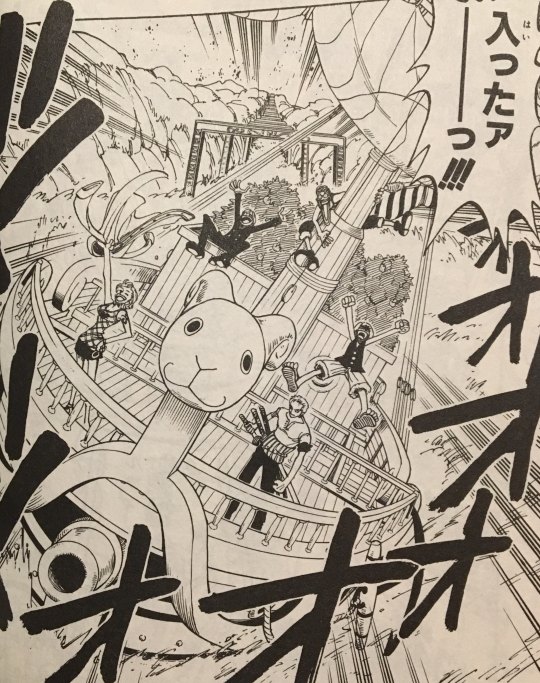
the entry into the grand line is such a great sequence. it feels like such an ending- a triumph after they’ve spent pretty much all of east blue struggling to make it here, and at the same time the beginning of a new adventure, the biggest yet, one that has yet to end a solid two decades later. they all look so happy to have made it here- it makes me smile.
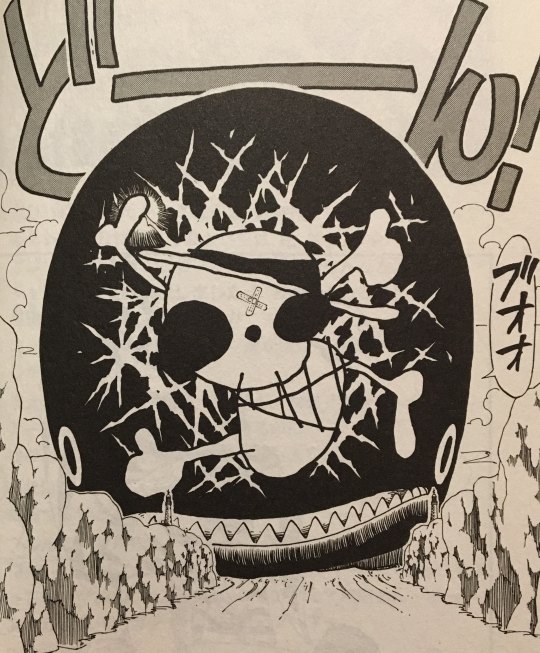
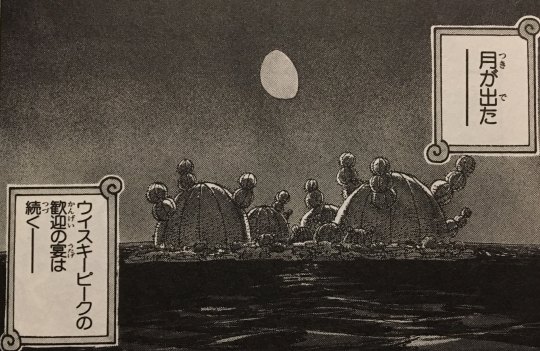
whiskey peak is one of my very favorite short arcs, and i think of the whole first half of the baroque works saga its the one that hits and maintains a tone best (almost certainly because its so short, admittedly, but still). i love the repeated shots of the moon, the reveal that the cactuses are actually covered in graves, the way everything seems far too good to be true at the start and the sense of suspense that creates.

zoro’s extended fight scene in whiskey peak is so great- it’s so creative and so dynamic and the odds are stacked so high against him and yet he’s clearly having so much fun. i do miss this sort of scrappy, improvised fight, cause its largely absent from later one piece but its SO much fun to read- zoro cutting holes in rooftops for people to fall through or shoving ladders to the ground as bounty hunters try to climb them.
i’m a huge fan of fight scenes that use the environment to their fullest, and this is such a perfect example of it. it makes the fight feel a lot more real and exciting, in my opinion.
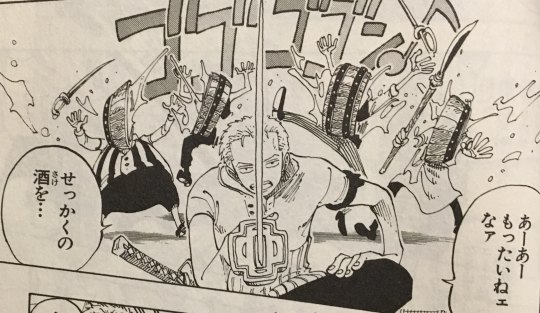

i’ve never liked zoro and luffy fighting at whiskey peak, its always struck me as frustrating and contrived and kind of out of character for both of them, but i will say that i do like how on the same page they are even when they’re trying to kill each other.

the entire first half of the baroque works saga basically serves to introduce and endear us to vivi so we’ll be invested in the alabasta conflict, and that starts here in whiskey peak, when we get our first glimpse of her actual personality rather than the act she was putting on as miss wednesday, when she bites her lip hard enough to bleed in order not to break down at igaram’s apparent death.
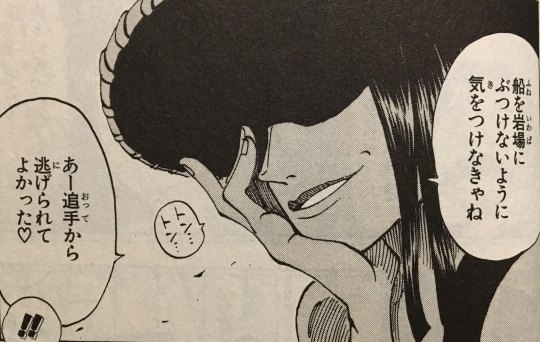
watching robin’s actions with the added context of later one piece is one of the great joys of rereading alabasta. she does a fantastic job of appearing to be crocodile’s most dedicated and capable and dangerous employee while quietly but consistently sabotaging his efforts; saving luffy, sparing pell, sparing igaram, not telling crocodile anything about the strawhats despite meeting them here at the very start of the saga.
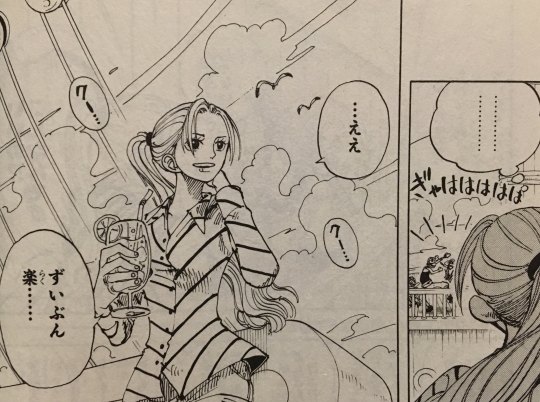

little garden has some really cool and striking panels that really put the scale of things on the island, the dinosaurs and giants alike, into perspective, and i love it.
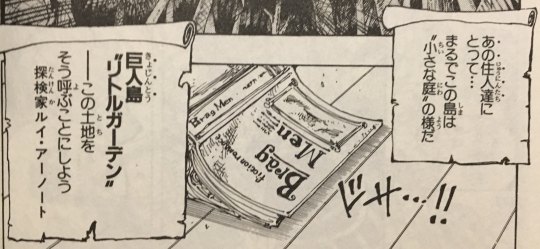
i’m a huge fan of the depth of in-universe lore one piece has. just having little details like this, quotes from books written in-universe, go so far towards making the world feel like a real and wondrous place with mysteries to be solved and details to be uncovered.


i still think sanji is firmly at his best when he’s being a sneaky bastard, and i will never cease to be delighted by how thoroughly he manages to fuck crocodile over with nothing but a phone and some quick thinking not once but twice.
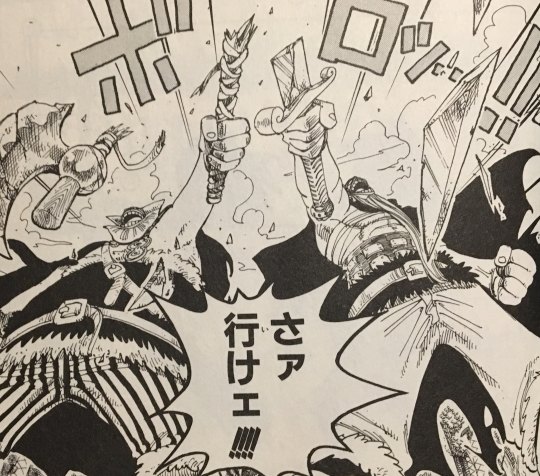
i really like dorry and brogy! for minor characters who’ve only appeared in one relatively minor and inconsequential arc so far, they’re not only very fun and memorable but also leave a hell of an impact on the story, not only in usopp’s new dream of eventually visiting elbaf but also in how they and their crew just keep coming up, first in enies lobby and then even further down the line in dressrosa and whole cake island.
i’m really excited for when we eventually get to reach elbaf, because this plot thread has been so thoroughly and subtly built up over such a long time that i can’t wait to see how it ends.
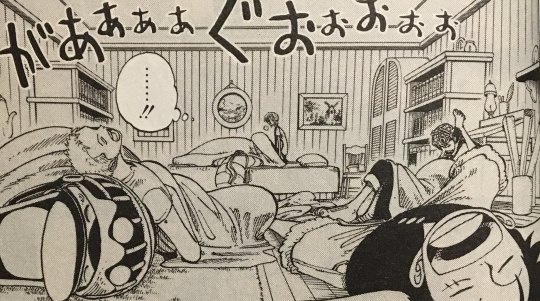
this is one of my favorite little moments to really drive home how much the strawhats care about each other. they all fell asleep on the floor rather than leave nami alone.
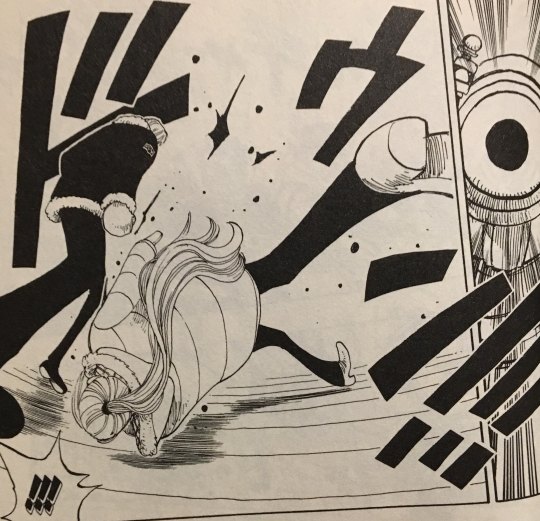
the whole introductory scene to drum is a really good summary of who vivi is as a person and how she contrasts with luffy, and it’s something i’ve written extensively about in a past meta. here ill just settle for saying, vivi is chronically selfless, and always the sort of person to sacrifice herself for others, and these traits which save the strawhats here are the exact same ones that bring her and luffy to blows later on in alabasta.
a good thing to remember when writing characters is that traits aren’t really inherently good or bad, they’re just traits and can have positive or negative consequences depending on the situation, and i think oda is really good at this. vivi’s selflessness, usually a positive thing, becomes reckless self-sacrifice when she’s pushed to her breaking point.
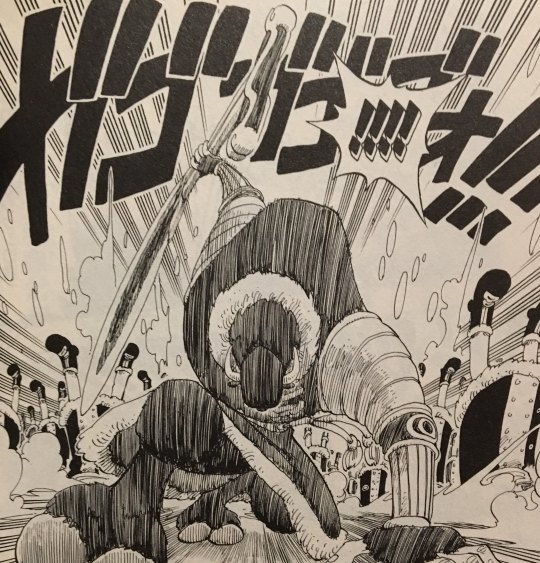
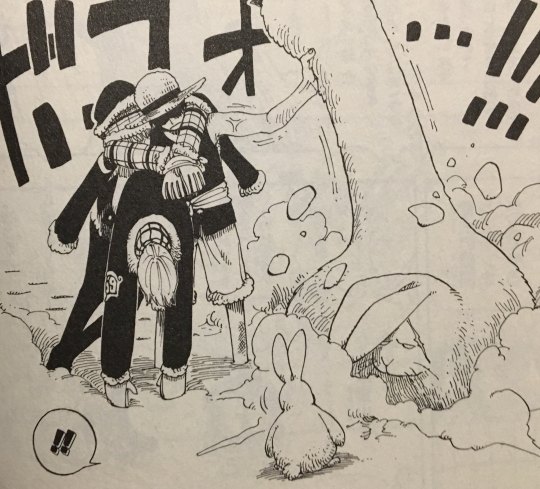
‘kindness begets kindness’ is a pretty consistent theme throughout one piece, though luffy is most often on the other side of it. someone (rebecca, law, tama, etc.) does something for him without really expecting anything in return, and gets paid back a hundred times over. this is a case of the opposite- luffy helps someone offhandedly, and is later saved by their gratitude.
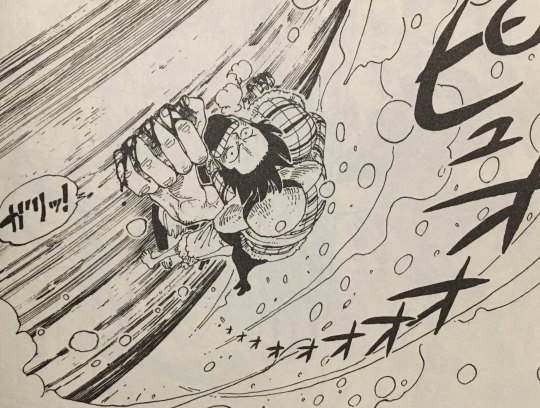
i think luffy wearing his fingers bloody as he climbs the drum rockies is the only time one piece has ever made me cringe back from the page. this sequence is absolutely brutal, and it’s so well-done.
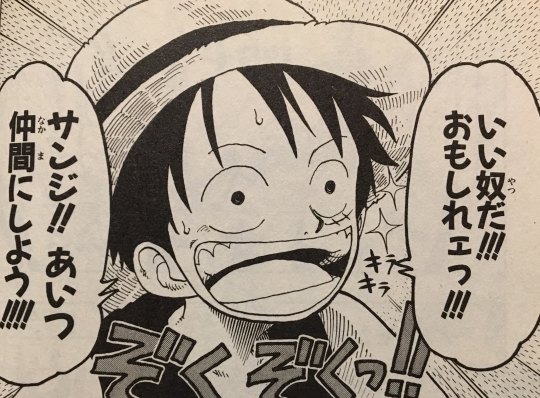
the way luffy decides chopper should be his crewmate is precious, and also reminds me a little of his recruitment of sanji (ironically, given he’s talking to sanji about chopper here). in both cases he sees someone do something good without even really knowing the full extent of their abilities and makes a snap decision that they are awesome and are gonna be part of his crew, no matter what they have to say about it.

i really, really enjoy the way the drum island flashback is set up, with the cutaway right as luffy is about to punch wapol’s lights out. the cut back to that punch finally hitting when the flashback ends is by that point infinitely more satisfying, since you’ve just read chopper’s backstory and therefore have a deep and abiding desire to see wapol eat shit.


hiriluk’s final speech is definitely one of the best and most memorable quotes from one piece, and effectively the crux of one of its biggest themes. one piece is all about inherited will. all of our main cast and a solid percentage of the supporting cast bear the legacy of at least one forebear on their shoulders, from kuina to corazon to otohime. the entire setting of the story is defined by roger’s legacy.
all those people are dead, but they’re sure as hell not forgotten- how can they be, when their legacies are actively shaping the world as a direct result of their lives and influences?

i really, really like the use of flags in one piece. flags are how you declare loyalty or war in equal measure, and flying a pirate flag is a declaration that you’re choosing freedom, come what may, over the laws of the world government. it’s just a really excellent running motif, and a great symbol of what one piece’s definition of piracy means.
this scene is also one of the ones that gets even more extra weight behind it when you know luffy’s full backstory with sabo, which i love.
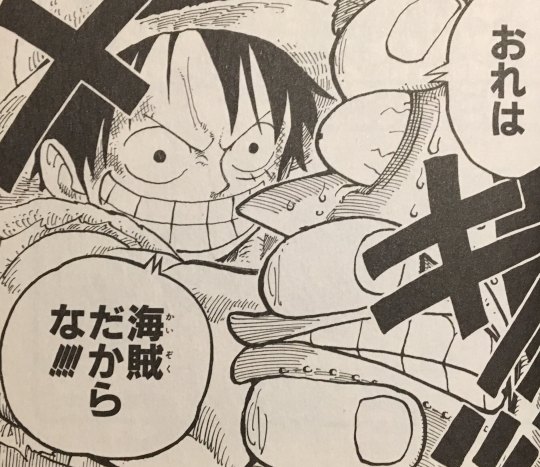

chopper’s recruitment scene sums up one of the reasons luffy is really great. he just doesn’t care about a lot of things other people would normally take notice of. occasionally that gets him in trouble, but other times it leads to him responding to a situation exactly right, like here. chopper is listing off all his insecurities and reasons he can’t go with the strawhats, and luffy just flat doesn’t care. he wants chopper on his crew and he knows chopper wants to be on his crew, so as far as he’s concerned, there’s no issue at all.
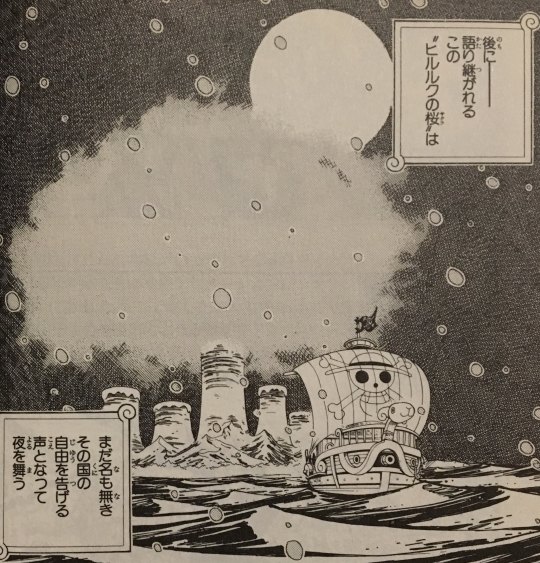
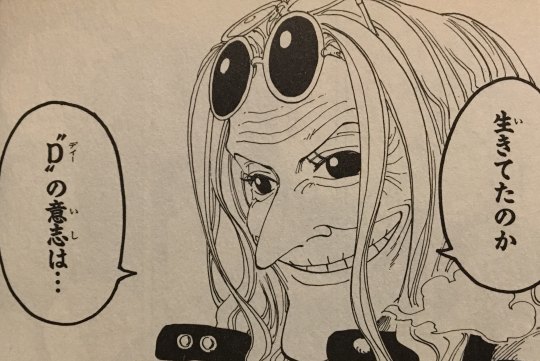
it really is wild that the will of D is named this far back in the story, and has consistently been referenced and built up ever since in very slight ways, through comments by characters like robin and corazon, and yet we still know basically nothing about it.
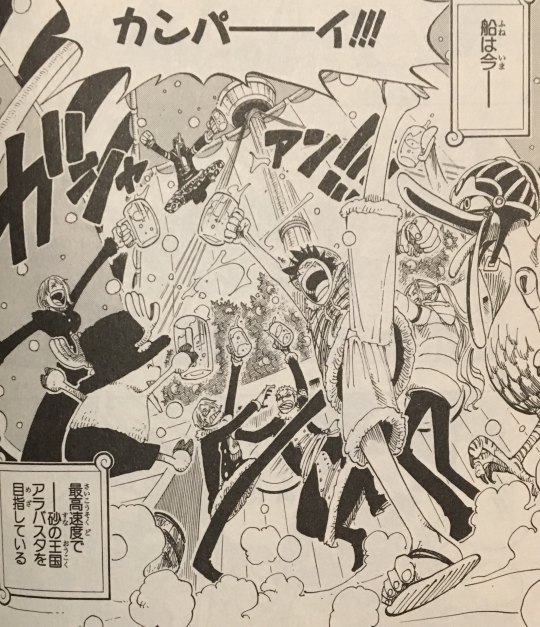
and a toast to a new crewmate!!
continued in the next post, which covers alabasta arc proper.
#the voyage so far#arc: reverse mountain#arc: whiskey peak#arc: little garden#arc: drum island#one piece#opmeta#not japanese#long post
150 notes
·
View notes
Text
I’m really fucking tired of people automatically accusing people of hating redemption arcs and not realizing people can change because they complained about ONE redemption arc being ill conceived or poorly executed. Like yeah, people can change and grow to be better people, and being redeemed doesn’t mean others need to forgive them, but guess what? That doesn’t mean that the redemption arc was good! It doesn’t mean that the arc was satisfying or well suited to the show! If your villain crosses certain lines, then they’re going to be very hard to sympathize with when they have a face turn. That’s just how it is.
Take Steven Universe: I’ve been an avid fan of that show for years, I love it to death, and I will be the first person to tell you that anyone saying that it supports fascism is a fucking idiot. HOWEVER, I also think the Diamonds’ redemption arc was horrible. It basically required one to focus on the family drama and relationships of the diamonds at the expense of what made them actually EVIL.
Sure, perhaps they were always meant to be a depiction of toxic family relationships as viewed through a lens of cartoon heroes fighting cartoon villains, but the fact of the matter is that even if you want the whole conflict to be a metaphor/consequence of realistic family drama with much more wide reaching consequences-which can TOTALLY be done btw, that’s perfectly fine- you still need to set things up in a way that makes reconciliation believable and not a huge miscarriage of justice.
The Diamonds were HORRIBLE people who killed countless of their own subjects, turned dead revolutionaries into twisted monsters still suffering in immense pain in a bid to destroy humanity, and wiped out countless worlds (admittedly, the writers said that humans were the first sentient organic life they found), and yet because they had an epiphany about their home life, we’re just supposed to accept that and move on. It doesn’t work like that. Even if the whole conflict is a dramatization or metaphor for familial strife, you still need to pay attention to the literal events actually happening. I’m not going to disregard the actual war going on and the consequences thereof because we’re focusing on the personal feud at the center of it all and it happens to be resolvable. I admire their attempts to resolve some of these issues in Future, where Yellow is shown in the process resurrecting the subjects she murdered, but the arc itself was still very forced.
Steven Universe really is the perfect example for this discourse because it has one terrible redemption arc amidst a sea of good ones. Lapis and Peridot had great redemption arcs that dealt with their personal issues in ways that made us like them and sympathize with them. Peridot was easy because she was mainly comic relief, but it was still a very moving redemption when she was shown getting her first taste of freedom and growing to love the planet. Lapis, while somewhat divisive, was an even better one in my opinion. Sure, it took a while, and even towards the end, she still had major issues throughout, but her character was built in a way that made it so you WANTED her to come around, and even though she had major issues throughout, it was always clear to the audience that she was never a BAD person at heart, and she never went too far down the path of evil to be forgivable.
Spinel is probably the one of the best redemption arcs I’ve ever seen, definitely in my top 3. I’d even put her above Zuko in some respects, though mostly due to personal preference. That’s really impressive considering that not only did she try to blow up the planet, like the diamonds did, but she also came soon after the polarizing Diamond redemption arc I just cited as a bad example. Spinel was everything the Diamonds should have been. Menacing and clearly unhinged, irrational in her goals of vengeance, and extremely dangerous, willing to end the world for what is for all intents and purposes a personal dispute with a relative (a very serious one but nonetheless), yet somehow still sympathetic throughout.
Unlike the Diamonds, Spinel was a character the audience WANTED to see redeemed throughout the whole film, even through her actions were still pretty terrible. A part of this is that we see more of her personality and struggles in the film than we see of the Diamonds’ in the whole series. We learn to like her and sympathize with her plight. It helps that she’s extremely entertaining. The other part is the main crux of the issue at hand really, and that is: SPINEL NEVER KILLED ANYONE!
This is the main issue I have with this whole debate. People get accused of refusing to let people change or let characters have any flaws when all they do is hold people accountable for anything AT ALL. Yeah, if a character crosses certain lines, I won’t want them redeemed. Sure, what those lines are depends on the scale and scope of the work and how seriously these actions are treated/ what consequences they had, but they exist and some crimes simply aren’t forgivable.
It’s easy for me to forgive Spinel because her actions caused mostly temporary damage. No one died. The Diamonds killed tons of people, including humans defending their home from destruction. Liking one doesn’t mean I have to like the other. Forgiveness doesn’t come for everything. Yes, I know the victims don’t need to forgive the villains as part of a redemption arc, but you know who does? THE AUDIENCE. The audience is pissed at these people too, you need to win them over. Their forgiveness doesn’t come just because the author says it should.
“Oh, but some people are more forgiving than you.” Fine, let them like this stuff, but if every fucking show I watch redeems villains after making them seem like the worst people ever, I won’t like it and I WILL express my opinion on the matter. I’m sick of every villain NEEDING a redemption arc. So many works go for the forgiveness angle in the end with little to no buildup.
To be clear, I don’t hate redemption arcs. In fact, I love them. Some of my favorite characters are ones who underwent redemption arcs. My favorite character ever (Crona from Soul Eater, but you don’t necessarily need to be familiar with them for this) started out as a villain before becoming a hero. I actively prefer the anime version of the show they’re from because it gave them a happier ending. Catra from Spop is another fantastic example. Both of these characters hit many of the same notes as the positive examples I listed above. Those are just the two best examples I can think of for redemption arcs in my opinion, but there are certainly more.
I’ve even desired redemption arcs for characters we WEREN’T supposed to want one for. Chara from Undertale, Seryuu Ubiquitous from Akame Ga Kill, possibly Toga from MHA though I’m actually somewhat hopeful about her (if Endeavor can have one, she should too). All of these characters are ones I feel are compelling enough characters that I actually waved my usual threshold for crimes I can forgive. I still get why it didn’t happen, mind you, I’d just kind of like it.
So yeah, I love redemption arcs. When used well, they can result in some of the most interesting characters in the work. But that doesn’t mean my love for the trope is unconditional. Like any trope, it is a tool. It can be misused, and when it is, it’s fucking infuriating. Nothing is more rage inducing than a villain not facing consequences for their actions. A redemption arc that doesn’t work is literally just that presented as a good thing. Few things are as infuriating as a work have something infuriating happening and telling you to celebrate. It’s like someone punching your teeth out and demanding payment for the dental work.
#redemption arc#fandom discourse#steven universe#atla#soul eater#shera#spop#akame ga kill#undertale#my hero academia
32 notes
·
View notes
Text
DA Fandom and moving forward - Calling In vs. Calling Out
Hi everyone,
As a PoC member of the DA fandom, I felt I have been quiet for long enough on the issues that have been presented recently. I am not here to argue against or on behalf of any individual or group, I am only here to present some information that I hope will be helpful moving forward. This is a long post, but it’s my hope that if you read it and want to help contribute to making this place better for everyone, then you will be willing to try to put what is said here into practice.
Since I am a relatively small blog, I wanted to start with a little personal introduction that will segue into the topic at hand. My name is Liz (you can call me Jade too, that’s part of my middle name), and I am a mixed race, “ambiguously brown”, aspec person from Canada. I grew up around mostly other immigrant families, attended predominantly non-white schools that were run by mostly white admins, and completed my degrees at a very white university in a field that does not have much racial diversity. I have experienced racism first-hand many times including, but not limited to, name-calling/slurs, fetishization/exotification, being followed by staff, people second-guessing my name, jokes about hurting/killing people of my race, etc. as well as witnessing racism directed at my friends and peers. I know exactly what it’s like to be exhausted and feel unsafe or othered.
There is, however, one thing I need to point out about the multitude of instances of racism I’ve experienced - most of them were caused by ignorance, and not malice. Yes there are absolute assholes out there, but personally I can count those people I’ve encountered on one hand (I am not speaking for everyone, though). The vast majority of racism, bigotry and general harmful acts come from a place of ignorance, particularly on left-leaning tumblr (to clarify, this discussion is centered around well-meaning people and not the actual lost causes). When I say ignorance, I don’t mean a lack of education or intelligence, I mean not being able to see or understand an issue from another person’s perspective. It’s not quite the same as empathy either (where empathy means you are able to feel another person’s emotions), but fighting ignorance does require empathy. It also requires knowledge on the context of the specific situation, and that I believe is the crux of the problem.
I think the main reason why this is issue is particularly prevalent in the DA fandom is a result of the too-close-to-reality-to-ignore inspirations that have been confirmed by the devs. Yes, it’s fiction, but there are also a lot of people that see themselves (mis)represented in the themes and characters. And what one person sees as disrespectful, another person may not see at all. This can come full circle, too, for example: one person sees themselves and their trauma represented in a character, another person sees their race misrepresented in the same character. Person 1 uses the character as a comfort character or coping strategy. Person 2 thinks using that character in certain situations is disrespectful. Neither one sees the other’s perspective.
This is where intersectionality starts to come into play, and requires empathy and effort to address the intentions and emotions of the other person. Perhaps person 1 is LGBTQ+ and has been traumatized by being as such, and uses Dorian as a character to explore their trauma. Perhaps person 2 is Brown, and racism towards their people is their trigger, and thinks person 1 did not do Brown representation justice in their creative works.
Looking at this more specifically, person 1 may have put Dorian in sexual situations. Person 2 feels that the way it was conveyed was fetishist or exotified. Person 2 doesn’t know person 1′s intentions. Person 1 is not aware of certain descriptions that are racist (e.g. using food to describe a PoC’s skin tone). Perhaps person 1 was self-inserting and wanted to feel desirable on their own terms, but this gave person 2 that squick factor.
Now person 2 wants to address this issue, and I think this is where a call-in (not a call-out) would be appropriate. Here is a good infographic that compares the two:
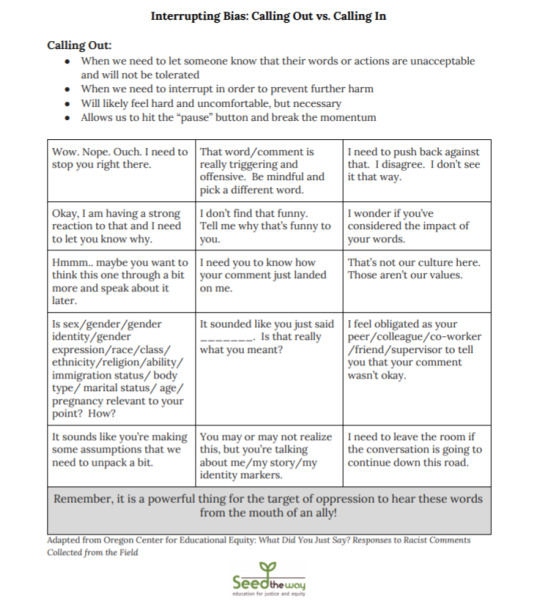

(Original source)
Note that there is quite a large difference in the language used. Going back to the above example, person 2 could privately message person 1 asking them why they chose to represent Dorian the way they did, with specific examples, and using call-in language (and I’m going to get back to this in a minute).
The point of this post and infographic isn’t meant to tell marginalized groups how they should be bringing up issues (though it is a good guide if you are concerned about being polite, particularly to a first time offender), it’s intended to demonstrate to people unintentionally participating in harmful behaviour what a call-out vs. call-in looks like. For PoC and other marginalized groups, yes it does take emotional labour to use call-in language and to try to understand someone that wounded you (here is a good read that incorporates the concept of emotional labour for call-ins, and discusses asking yourself if you are ready to do so). For the people who have unintentionally hurt a marginalized individual or group, please understand that someone calling you in is not an attack, it’s a chance to explain why you expressed something the way you did.
That being said, we may have reached another hurdle. What if you call someone in, and the person called in does not want to discuss the fact that they were inserting their personal trauma? I think this is where things start to get a bit messy, but I am of the opinion that if you’ve unintentionally triggered someone else’s trauma through ignorance present in your work, you owe it to them to at the very least mention that you were inserting your trauma, without having to bring up specifics (anyone is allowed to set boundaries). From there, the discussion can be hopefully be opened up to learning from each other, and reaching a consensus. Sometimes that consensus requires the creator to edit or remove their work. As an addendum, if you are a creator that unintentionally hurt someone with your work that didn’t have an ulterior personal motivation, it’s your responsibility to understand why what you did was wrong, apologize, remove the work and do better next time. I know some people cherish their OCs, but you are allowed to change your perspective and make adjustments to your character without erasing them entirely.
Now we’ve reached another potential obstacle - what if an offender doesn’t respond to your call-in? First of all, ask yourself, did you actually call them in, or did you attack them? Here is a good opinion piece from a Black professor on this matter. I’d like to clarify that I am not trying to tone police, I am speaking as someone that used to go ham on ignorant people on Facebook and Reddit, and has since changed their tactics and has even gotten through to Trump supporters (some of this stems from my spiritual growth as well, but that is not the point here).
There is another issue to address here now as well - what if you have tried, repeatedly, to call someone in and they just don’t change their behaviour? Alright, then it’s probably time to call them out. But again, ask yourself, did you truly try to get through to them? If so, well, at the end of the day, some people are, unfortunately, lost causes.
In summary, a call-in is meant to come from a place of wanting to help someone who has seemingly gone astray, because you are worried about their thoughts, feelings, and behaviours towards a marginalized group. You know that if they made a mistake it isn’t them, isn’t their heart, and you want them to be able to understand why what they did hurt others, and give them the chance to correct themselves. It comes from a place of love and acceptance, because you don’t want your friends to harbour negative beliefs.
Finally, I want to give a real example of this in action. My cousin is a photographic artist, and was recently called in to discuss the nature of one of her pieces. Her subjects are usually people, and they come from a wide variety of backgrounds. To help support BLM (she does a lot of work to help fight racism in general), she auctioned off one of her pieces. The subject of the piece happened to be a Black woman. She was called in by Black members of her art community to discuss how people bidding on an art piece that featured a person from a marginalized group perpetuated the ogling and monetization of Black people. She gave a response that acknowledged that her piece did perpetuate this issue, because she wanted to raise awareness of this historical harm, and recognized that her intention was ignorant of this perspective. The Black community also acknowledged that the piece itself was not harmful in any way, only that the surrounding issue that they were painfully aware of needed to be brought to light. The auction went ahead, and the piece sold for ~$1000, all of which was donated to BLM.
I think as a fandom we should be cognizant of when a work itself is harmful, or when the intention is harmful. Sometimes they overlap, sometimes they don’t. Both are talking points, and we should not be afraid to discuss them, but this requires respect from all parties. We also do need to be able to recognize what is strictly fiction, versus what has real-world impacts.
My askbox is always open and my DMs are open to mutuals if you would like anything clarified or expanded upon. Or, if you’d just like to discuss a topic, vent, or have any questions about my own beliefs, you are welcome to reach out. I am happy to discuss anything, as long as there is mutual respect.
#fandom critical#da fandom#da fandom critical#fandom racism#tw: racism#tw: trauma#dragon age#dragon age inquisition#call out culture
191 notes
·
View notes
Text
Star Wars: The High Republic Informal Review
These are my initial thoughts and minutely biased opinion/review of the High Republic.
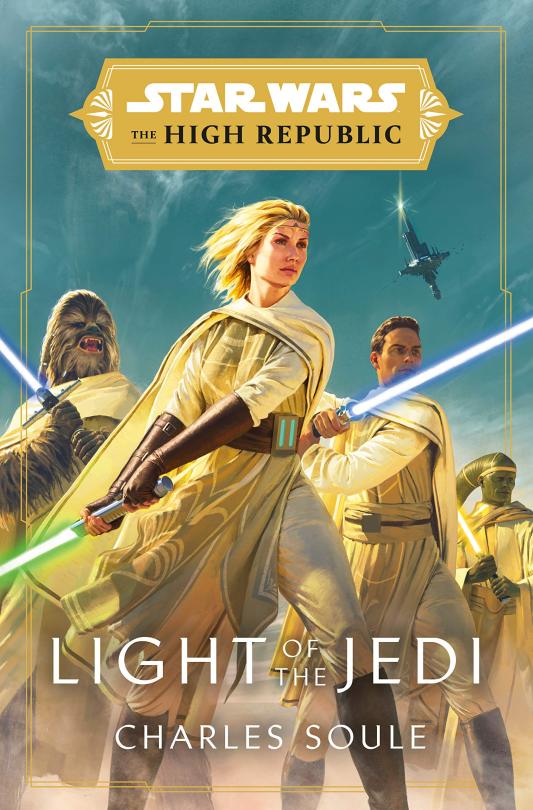
My basis is primarily founded on the first two issues of the High Republic comic book – written by Cavan Scott – along with a secondary basis, from a secondhand account of the book Light of the Jedi, written by Charles Soule. It is a secondary account because I don’t read books; I am not a book man. My friend loves to read books and he graciously gets on Discord with me basically every day and together we dissect and discern what’s going on in this new period of the galaxy.
This evaluation will mainly concentrate on the book portion and while not all encompassing, will give you a significant gist of how I’m feeling about High Republic. Also, there will be SPOILERS – you have been warned.
Overall, the book seems to have a strong first third, gets into a lull in the second third, and somewhat recovers in the last third but, arguably not as strong as that first third. The strengths of the book are definitely world building, the focus on Starlight Beacon, and finally, the introduction to all the new (old) Jedi; the Jedi are the best thing about the book.
Plot wise, the book centers on and around Starlight Beacon with hyperspace being the driving force of the conflict.

Starlight Beacon is akin to an amalgam of air traffic control, a mutli-cultural embassy, a Jedi Temple, and a bazaar. At this point, it housed the largest number of Jedi outside of Coruscant and used signals to guide travelers during their interplanetary journeys. It was made in response to the Great Disaster – a hyperspace tragedy that caused starships all across the galaxy to be abruptly launched out of hyperspace leading to several moons in the Trymant system, including Korbatal, to be destroyed. Beacon exists to better calibrate for, identity, and curtail these new anomalies as astromech droids are a rarity in this period of time.

Around the same time, a marauder group – called the Nihil – have found a way to board and raid ships while they are in hyperspace using hyperspace channels termed Paths. Through the use of devices - called Path Engines - Nihil ships are to make short-burst hyperspace jumps, allowing them to appear and disappear in a flash during battle. Their raids have led to deaths, including that of Jedi Jora Malli - a Togruta Jedi Master that sees the Force as a force – always in competition with itself. She was also very close friends with Sskeer; a Trandoshan Jedi Master that lost an am during the raids.

In accordance with that last point, hyperspace will be somewhat of the crux contention to fans (and really science fiction enthusiast in general) as this is not how hyperspace has generally been established to work in Star Wars yet, is the lynch pin in how conflicts happen. This even follies with the newly established way hyperspace works in The Last Jedi and The Rise of Skywalker but, I digress…

I knew there were going to be some major plot holes in this super prequel series but, my best hope was that they wouldn’t be too gaping. Just knowing that this application exists, changes many aspects of space travel and what characters going forward should know about it.
Canon mechanics aside, Charles Soule makes it clear why was given this duty; he has blatant skill for writing not only characters but, also taking the extra steps of having the individualized power of the character be an extension of them. He did this very well during his run in Uncanny Inhumans and he’s not disappointing here either (he’s had plenty of practice in the Star Wars realm already with books like Star Wars, Poe Dameron, and The Rise of Kylo Ren).
There are a multitude of Jedi brought in, which complements the time period and era of it being the High Republic but, the real asset of the book is Soule taking the needed time to give the reader a look at how each Jedi interprets the Force in their own way. Moreover, the pairings of different Jedi serve as accompaniments to each other in very noteworthy ways.

Jedi Master Loden Greatstorm, sees the Force as an ocean.

His Padawan, Bell Zettifar sees it as a flame – sometimes a raging inferno, sometimes glinting ember. (This is very fascination as usual flames are a motif associated with the Sith yet, here is Bell - a shining example of a Jedi - interpreting fire in a positive light. I also like how view of the Force allowed him to synch with his charhound, Ember).
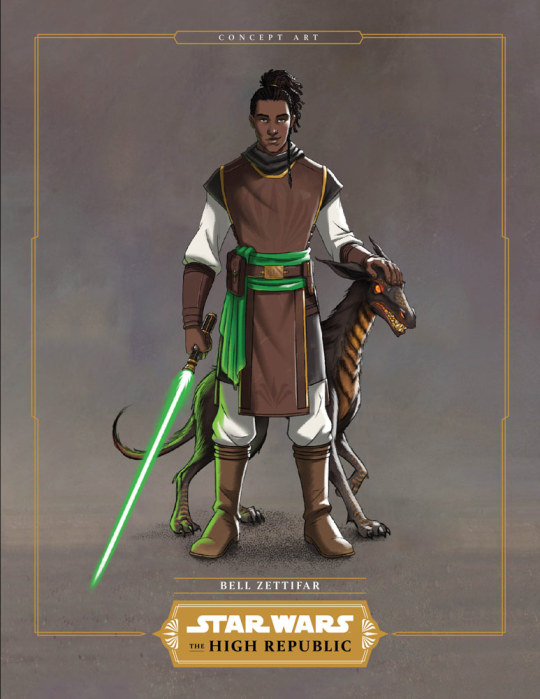
Wookie Padawan Burryaga Agaburry, perceives it has a tree attached to a leaf of equal size.
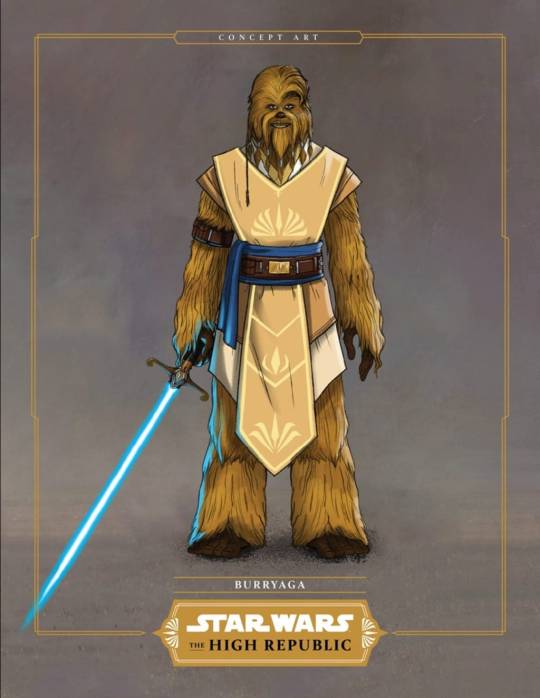
Vernestra Rwoh, the one of the youngest Jedi Knight in the order, sees it as a river.
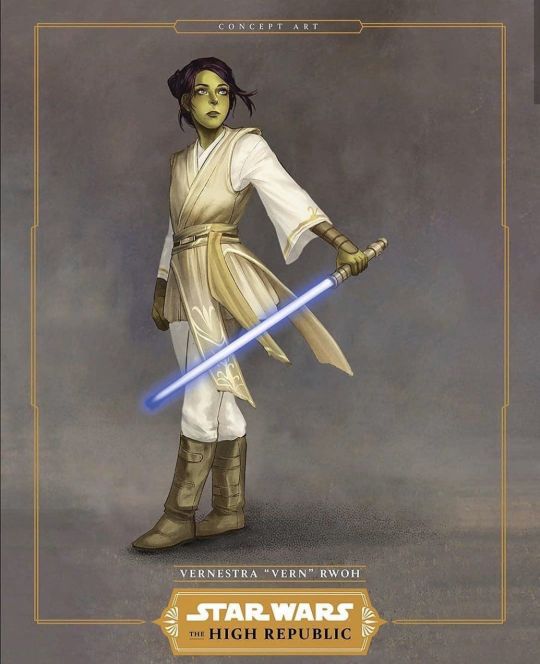
Reath Silas, see it as a spider web – strong in some spots, weak in others.

Elzar Mann, views it as an endless, bottomless sea which was impossible to be used up, not matter for what purpose or however many times it was called upon. (I’m curious to see if there will be a differentiation between how Mann sees the force when compared to Greatstorm; an ocean is deeper than that of a sea.)

Finally, Jedi Master Avar Kriss, hears the Force as a symphony – moreover, she can connect with minds of other Jedi and is able see how other see how they see the Force.

Hot take but, the character of Kriss feels like a Kathleen Kennedy character as Kennedy been prone to interject White, third wave feminism (if you’re not intersectional then you’re not a “feminist” to me) into Star Wars. One of her signatures is to take a White human female and make her the either the main character or a key figure in the narrative. Avar Kriss, a White blonde-haired human woman, is literally depicted as “the brightest, most noble example of Jedi-hood” so, I’m keeping a keen eye on her – doesn’t help that she just got assigned Marshall to Starlight Beacon but, if it’s any consolation (more like mitigation), she was the SECOND pick as the first died.
Ultimately, if you are able to get the major hurdle that is hyperspace Paths, this is a competent and enjoyable start.
Soule even goes as far to add some interesting and even practical – yet lore breaking – devices in this age: he’s made a new (old) space ship called “Vectors” that are powered/steered by Force sensitive people with the lightsaber being the key to active it (even cooler, the hub takes the color of the lightsaber that activates it).

That’s a great idea and makes sense within the universe as whole yet, collapses on itself when you remember what time period, we’re in – the past, so why was this not built upon in the future?
It definitely feels like the books are 85% of the story while the comics (more on them in a later post) are – at their prime peak – a mere “intrinsic 15%”.
The best part for me has been the characters; hopefully, the plot will come along to accent them justly.
Arguably though, the best characters – that of Loden and Bell – should be depicted in the comics based on their gravitating dynamics and instant attachment with readers.

#star wars#the high republic#high republic#charles soule#light of the jedi#starlight beacon#loden greatstorm#bell zettifar#burryaga agaburry#vernestra rwoh#vern#reath silas#elzar mann#avar kriss#jora malli#sskeer#hyperspace#nihil#the path#vectors#kathleen kennedy#uncanny inhumans#the rise of kylo ren#poe dameron#the last jedi#rise of skywalker#cavan scott#white feminism#intersectional feminism
45 notes
·
View notes
Text

When A Scot Ties the Knot. By Tessa Dare. New York: Avon Books, 2015.
Rating: 3/5 stars
Genre: historical romance
Part of a Series? Yes, Castles Ever After #3
Summary: On the cusp of her first London season, Miss Madeline Gracechurch was shyly pretty and talented with a drawing pencil, but hopelessly awkward with gentlemen. She was certain to be a dismal failure on the London marriage mart. So Maddie did what generations of shy, awkward young ladies have done: she invented a sweetheart.
A Scottish sweetheart. One who was handsome and honorable and devoted to her, but conveniently never around. Maddie poured her heart into writing the imaginary Captain MacKenzie letter after letter … and by pretending to be devastated when he was (not really) killed in battle, she managed to avoid the pressures of London society entirely.
Until years later, when this kilted Highland lover of her imaginings shows up in the flesh. The real Captain Logan MacKenzie arrives on her doorstep—handsome as anything, but not entirely honorable. He’s wounded, jaded, in possession of her letters… and ready to make good on every promise Maddie never expected to keep.
***Full review under the cut.***
Content Warnings: graphic sexual content, blood, violence
Overview: I came across this book while doing research for a blog post on Scottish fetishization in romance. While writing the post, I encountered YouTuber Jean Bookishthoughts’s video “ An Actual Scot Reads Highlander Romances,” and she gave this novel a fairly positive review. So I decided “why not? I’ve got nothing better to do.” Overall, the premise of this book was really enticing - the idea of a woman writing letters to a fictional sweetheart only to have a flesh-and-blood man show up at her door is quite the setup. I also think Dare does a good job of writing humor and moving the narrative along. But I ultimately couldn’t give this book more than 3 stars for a number of reasons: for one, the main crux of the plot felt like it could have been a bit more robust. Two, I didn’t find Logan to be a very interesting character. And three, some of the random “Highlander” references felt cheesy.
Writing: Dare writes prose that is quick, witty, and humorous. I very much enjoyed the jokes and the banter between our protagonists, and I appreciated that Dare didn’t get bogged down in some of the details of day-to-day life. If I had any criticisms, it would be that I think Dare moves almost too quickly at times. Some of the more emotional moments could have used some room to breathe or some more description of how the characters’ emotions are faring. But it wasn’t so bad that I felt like I was being rushed through the novel. Another way of putting is may be that sometimes Dare told where she could have shown, but the balance of telling vs showing didn’t feel egregiously off.
Plot: This plot mainly follows our heroine, Maddie, and our hero, Logan, as they try to work out an agreement. Maddie, in the attempt to avoid going on the marriage mart, invented a sweetheart at age 16 and wrote letters to a “fictional” Scottish captain in the army for years. Unbeknownst to her, the letters were actually being received by Logan, and when he and his men come home from the war, Logan is determined to marry Maddie in order to get her land in Invernesshire.
Personally, I found this setup to be quite intriguing and whimsical. I liked the embarrassment that arose from Maddie’s letters actually being received and read. I liked that Logan secretly looked forward to the letters from a stranger. I even liked the dilemma of negotiating a marriage of convenience. But I think where this plot fell apart for me was the whole challenge of consummating the marriage. Logan and Maddie agree to marry and live separate lives (it’s early on, so this isn’t really a spoiler), but Logan is adamant about consummating the marriage so that there’s no possibility of an annulment. Maddie, for her part, wants to avoid consummating the marriage because she finds that marriage will threaten her career prospects; as an illustrator, she finds that men will not hire her for work if they think household or parenting duties will interrupt her work schedule. To be completely honest, this challenge was quite good; I thought there was a real opportunity here for Dare to explore the sexist challenges women face in the workplace. Where I thought the challenge was weak was in the whole obsession with consummation. Unless there was such hostility between the Scottish and the English that an Englishwoman’s word would always be taken over a Scotsman’s, I found the question of “did they actually have sex or not” to be quite trivial. From what I know, annulments were notoriously difficult to obtain, so it wouldn’t matter much if Maddie and Logan had consummated the marriage. It seems like Logan could just say they did and an annulment would be near impossible. Nor do I think the law would care much if they only had non-penetrative sex. It seems like the whole plot hinging on whether or not they had “real sex” was a non-issue for me.
Instead, I would have liked to see more conflict in Maddie between balancing her desires for romance and a family with her career aspirations. Once Logan enters the picture, it seems like her career takes a backseat (except for a couple of scenes), and I would have rather seen it be more front and center. Either that or I think Maddie’s story could have mirrored her aunt’s more closely. Maddie’s Aunt Thea was long ago caught up in a scandal that ruined her, but later, Thea reveals that she had enjoyed the freedom. I think having Maddie be independent and struggle with the idea of being “tied down” by marriage could have also been good, and while there’s a little of that, I think it could have been more apparent to the reader.
In terms of small-scale narrative points, I think a lot of the scenes Dare writes are very funny and entertaining. I liked, for instance, the scene where Maddie falls into a bog, or when Maddie shows kindness to Logan’s friend, Grant. The scenes that truly did bother me, however, were some of the more “fluffy” ones that were a bit too cheesy for my tastes. For example, there’s a scene in which Maddie finds Logan reading Pride and Prejudice and he’s wearing spectacles. She makes a big deal about him being a reader and I had to roll my eyes. There’s also a scene towards the end in which Maddie attempts to make haggis, and I hated it because it felt like it was inserted so Dare could check off a “Scottishism” in a list. Tartan? Check. Brogue? Check. Haggis? Check. The scene also erupted in random violence, too, which felt out-of-place and inserted for pointless drama towards the end of the novel.
But I will admit, I did like the scenes that were very self-aware about what Dare was doing. For example, there’s a scene in which Logan is debating about what to do to get Maddie into bed. His friends give him suggestions like “offer your heart to her on a platter” or “throw in a lot of oochs and bonny lasses when you speak” or “dive into the loch and have her go looking for you. Then, when she’s found you, pretend you don’t notice her and have her watch you bathe for a while. Then emerge from the lock all dripping wet.” This self-awareness was a nice stab at romance cliches, though I wish Dare had done a better job herself at avoiding them.
Characters: Maddie, our heroine, is fairly likeable in that she’s bookish, generous, and a bit clumsy at times. I liked that there was a juxtaposition between her confidence and her social anxiety: while she wasn’t afraid to assert herself in some situations, big crowds made her nervous, and I think navigating those two scenarios made for some interesting characterization. The main thing I didn’t like about Maddie was how quickly she seemed to give up her career ambitions for Logan. There’s a point where she has to make a choice between letting Logan go and following her dreams, and she claims that she’s choosing Logan even though the choice is really made for her based on sexist norms of the day. I would have liked to see her wrestle with her ambitions a little more.
Logan, our hero, has some admirable qualities, but in the end, I found him rather uninteresting. He’s your basic roguish Scotsman with a tragic past, and though I liked the loyalty he showed to his men, I ultimately though he was a little too jealous and a little too used to his orders being obeyed. I would have liked to see him be a little less dictatorial so that his romantic appeal would shine through a bit more brightly.
Side characters are charming but, in my opinion, underutilized. I liked all of Logan’s army buddies and appreciated that all of them had disabilities in some way (and those disabilities were important but didn’t define them). I really appreciated Maddie’s relationship with Grant, the soldier whose memory resets every hour or so. She was kind to him and he was sweet to her; I just didn’t think his random violent outburst towards the end was necessary or in-character. Maddie’s Aunt Thea could have also been used more effectively, but I did like that Thea had this quirk of making a lot of cosmetics and remedies that were, ultimately, rubbish. It was charming.
Romance: Logan and Maddie’s romance was... ok. The premise started out really interesting, but over time, I lost some enthusiasm because I felt like I was being told that they had feelings for each other (rather than being shown). Sure, Logan does some things that challenge Maddie’s assumptions and vice versa, but I wanted them to have a stronger basis for a romance than just “they’re hot and I’m horny oh wait they were nice to me and aren’t exactly what I expected.” Part of the reason I wasn’t super enthused might also be the focus on sex and sexual attraction as well as Maddie feeling pity for Logan on account of his past. I prefer romances where the focus is on each person lifting the other up emotionally, and while there was a little of that, I think I would have liked to see it be more of a centerpiece within the plot.
TL;DR: When a Scot Ties the Knot is a funny, light, historical romance, but ultimately doesn’t have a “meaty” enough plot for my personal tastes. Some readers might enjoy the banter and the heroine’s determination, while others might be turned off by the cheesiness and lack of a complex hero.
3 notes
·
View notes
Text
The Redemption of Judee Sill
Halsey Hazzard, fall 2018
for a writing class on pop culture criticism
“So much sensationalist bullshit has been written about Judee Sill (by people who never knew her) focusing on her days as a hooker and a junkie.” So begins Pat Thomas’s interview with Tommy Peltier, a longtime friend and collaborator of Sill’s, in the liner notes to the recently and lovingly compiled “Songs of Rapture and Redemption: Rarities & Live.” He’s not wrong; in nearly all of the writing on Sill, her music, an inimitable blend of gospel, folk and country at once bluesy and baroque, plays second fiddle to the stranger- and sadder-than-fiction story of her all-too-brief life. Her eponymous 1971 debut and 1973’s Heart Food were met with praise from critics and her fellow songwriters alike; in 1973 Steve Holden called Judee a “most gifted artist, one who continues to promise almost more than I dare hope for.” Unfortunately — for Sill and for those who loved her, and for those of us who love her music — much of that promise never came to pass. She died in obscurity in 1979, leaving behind an unfinished third record and quietly ascending to the pantheon of young, brilliant musicians who died too soon.
It’s hard to write about Sill without relying on sensationalist bullshit. I suppose in writing this at all I’m contributing to the problem, but like so many others, I have joined the ranks of Sill’s devoted disciples, compelled to tell and retell her story to rectify fate’s perceived cruel disservice to a great talent. What emerges is not always a faithful portrait of the complicated artist Sill was, but rather a shifting and sometimes contradictory fable that cements Sill’s status as a legend — not, as she might have hoped, as “an extremely famous or notorious person,” but rather as the subject of a “story sometimes popularly regarded as historical but unauthenticated.”
The story goes something like this: Judee Sill was born Judith Lynne Sill to an average, unhappy middle class household in Los Angeles in 1944. She fell in with a rough crowd, got married, committed a series of crimes, got addicted to various drugs, went to jail, got married again. Eventually she cleaned up her act, put the gospel licks she’d learned in reform school to good use, and became the first act signed to David Geffen’s Asylum label. She put out two albums of intricate songs that married earthly desire and longing for heavenly salvation, populated with lonely cowboy types and vigilantes that sometimes seemed strikingly similar to Jesus. For a few shining years it seemed like Sill had made it. It soon became clear (the story goes) that fame was not what fate had in store for her.
Until 2003, when Rhino issued Judee Sill and Heart Food on CDs for the first time as part of its Handmade series, Sill was “[u]nlamented and all but forgotten.” These are the words of Barney Hoskyns, who in a 2004 Guardian profile declared “[t]he tragic Judee Sill is well overdue for (re)discovery.” Since then, interest in Sill’s life and music has steadily increased thanks to a series of posthumous reissues and releases: 2005’s “Dreams Come True,” a two-disk set of unreleased recordings mixed by Jim O’Rourke (Sonic Youth, Wilco); Live in London: The BBC Recordings 1972-1973, released in 2007; and “Chariot of Astral Light,” an intimate collaboration with aforementioned Tommy Peltier recorded in the ‘70s and finally released in 2004.
In a review of the 2004 Intervention reissue of Judee Sill titled “The Judee Sill Cult Continues, This Time at 45RPM,” Michael Fremer of Analogplanet writes, “sometimes "legends" are created and nurtured simply by tragic circumstances. In Judee Sill's case add wasted talent and unfulfilled great promise that add up to a movie worthy story.” Sill’s life has yet to inspire a movie (although a seemingly-deserted IMDB page indicates at least one attempt at a documentary), but songwriter Laura Veirs’ “Song for Judee,” renders the Judee Sill legend in sparse yet cinematic detail. In it, Veirs’ voice echoes on top of warm, jangling guitars, the apparently upbeat melody betrayed by the sadness of the story it tells:
“You wrote “The Kiss” and it is beautiful
I can listen again and again
You never really got a break
From the car wrecks and the pain”
The crux of the Judee Sill legend is captured in these lines, which immediately identify Sill’s work with the tragic events of her life. Sill’s music is mentioned in Veir’s lyric but once, and only glancingly; it’s not even clear “The Kiss” is a song, or “Judee” a songwriter. Veirs’ appreciation for her music is given is as pretext for why the listener should care about Sill’s life, but it’s clear the main attraction here is tragedy. The rest of this atypical ode is not praise, but a retelling, addressed to Sill herself, of key moments in the legend of her life. What emerges is a tellingly concise fable that identifies Sill with the lonely phantom cowboys who populate her lyrical landscape.
Veirs appears to have lifted her narrative and several phrases from the BBC documentary. She mines in particular the commentary from Peltier, who says Sill was his best friend and shares the insights that would come to compose Veirs’ chorus: “You loved the Sons of the Pioneers and the Hollywood cowboy stars/you were just trying to put a hand to where we are.” She also borrows, nearly word-for-word, an introduction Judee gave during one of her London radio performances in 1972, describing her time “living in a ‘55 Cadillac, five people sleeping in shifts.” This almost creates an intimacy with Sill, whom Veirs had never met; however, there remains an insurmountable distance. Sill had been dead 35 years — as long as she was alive — by the time this ode was composed. While Veirs hints at Sill’s troubles in the first verse, only in the last verse does she make explicit what happened: “They found you with a needle in your arm, beloved books strewn ‘round at your feet”. The revelation gives the chorus retroactive prophetic relevance. The past tense, once wistful, is now crushing.
Her death, like her life, became part of the legend. There are general points of agreement: she had been in several car accidents, was using heroin again, and died of an overdose just after Thanksgiving 1979. Everything else is less clear. Though her death certificate reports she was found dead in her house in North Hollywood, a persistent rumor suggested she had disappeared to Mexico to live out her final days. Her death was reported as a suicide, but family members and friends maintain that the note found near her, a characteristic musing on death and redemption, was an idea for a song.
The title of a 2014 BBC Radio documentary by Ruth Barnes says it all: “The Lost Genius of Judee Sill.” Sill’s genius is preceded by its lostness. Sill herself comes last. Her music is mentioned too, of course. They quote Sill’s self-description of her work as “country-cult-baroque” and her professed influences, Bach and Pythagoras. (In some versions of the quote, Ray Charles is thrown in.) Yet every time, it seems, someone brings up that she wrote “Jesus Was a Crossmaker,” about JD Souther, that Graham Nash produced it. She was the inaugural artist on David Geffen’s Asylum, we’re told, .She opened for Crosby Stills and Nash, and Cat Stevens, and Gordon Lightfoot — and so on. These revelations are usually accompanied by astonishment at the fact that she failed to find the commercial success of her peers, despite her comparable — perhaps superior — talents.
Many have offered explanations about how this happened. There is a general consensus that her falling-out with Geffen played a role. It’s not exactly clear what happened. The word “faggot” was involved, but whether it was said live or on the radio, in reference to Geffen himself or a pair of his pink shoes, is up for debate. Whatever she said severed their relationship. Some contend that she may have been in love with him, and was hurt when he spurned her advances. Others point out that she was growing frustrated with what she saw as his lack of promotion for her music. By this point, she was already making no secret of her disdain for the “snotty rock bands” she had to open for, and I doubt this did her any favors.
The contradictions in people’s stories exacerbate the larger-than-life quality of her life and times, as do the many cliches used to tell her story. Headlines variously declare her “a star that fame forgot,” “L.A.’s doomed lady of the canyon who lost her genius to drugs,” a “mystic” who “walked among us.” The human Judee Sill is lost somewhere beneath this sensationalism. It is no wonder why her friends and family members, Tommy Peltier chief among them, feel so compelled to set the record straight by providing their version of events. In his remarks in “Songs of Rapture and Redemption,” Peltier is quick to discourage speculation about her drug use and past prostitution, declaring instead “She was just the most beautiful person.”
“Beautiful,” you may recall, was the only word Laura Veirs could come up with to describe “The Kiss.” When I first heard “The Kiss,” I was immediately struck by how inadequate the word was to describe what I was hearing. The song showcases the best of her efforts to induce mathematically precise intervals into intricate melodies that aren’t so much heard as felt. Her lyrics, confusing the sacred and profane, ride the thin ridge between love and logic, devotion and desperation. Over shifting and plaintive piano Sill sings a eulogy to stars bursting in the sky and begs a lover — god? — to come and hold her “while you show me how to fly.” I first heard “The Kiss” in a YouTube video, one of few that survives of her performing, whose introduction insists that she herself was determined to be a successful musician. Ironically, the video shows precisely why perhaps she couldn’t be: severe and guileless, Sill hunches over the piano as if it were all that exists, engrossed in the song’s intense and uncommercial emotional intensity.
Sill’s idiosyncrasies are on full display in “Songs of Rapture and Redemption”, a compilation whose greatest strength is its commitment to capturing the artist and all her contradictions in her own words. The sleeve features a candid photograph of a smiling Sill, alongside several of her paintings and drawings. The tracks included are a combination of live recordings, demos, and studio outtakes that lay bare the deceptive complexity of her compositions. In the Boston Music Hall performance that opens the record, Sill, armed only with an acoustic guitar, tells the audience “I’m going to sing you a few little songs before David [Crosby] and Graham [Nash] get here. I’d like to sing you this song called “The Vigilante”. It’s new, I hope I remember the words.” The self-effacing introduction notwithstanding, what follows is nothing short of revelatory.
An early highlight is “Enchanted Sky Machines,” a bluesy number about waiting for the end of the world where she trades her distinctive fingerpicking for pentecostal piano licks she picked up in reform school. There is an aching earnestness to the way she sings of swallowing her yearning, and it carries over into “The Archetypal Man,” which begins with Sill singing the song’s opening harpsichord solo. Before “Crayon Angels,” she describes how she would call up friends as she was writing the album and sing them instrumental solos, joking that it must have been hard for them to like her in those days. The crowd is in on it, and her self-deprecating humor belies a clear confidence in her talents and her musical vision that is justified by the virtuosic grace of her playing. Sill was a perfectionist who demanded and deserved creative control, a notoriously laborious songwriter who could be a tyrant in the studio, and these tendencies are on full display even in this humble solo set. When she introduces her second last song, “The Lamb Ran Away With the Crown,” she enunciates every word, then repeats it again — ”with. the. crown.” — determined to ensure the the audience walks away knowing exactly what she was saying.
The set ends with Judee’s signature song, “Jesus Was a Crossmaker,” which had only just been released to radio two days prior. She calmly reveals the song’s inspiration, an unhappy relationship with a “bandit and a heartbreaker,” and describes waking up one day with the conviction “that even that wretched bastard was not beyond redemption.” Her diction is clear, her tone less so. The audience, nonetheless moved, cheers and laughs. She goes on: “It’s true, I swear. It saved me, this song. It was writing this song or suicide. It’s called “Jesus is a Crossmaker” and I hope you like it.” Her voice seems monotonous for such an emotional confession, but that stops mattering as soon as the song begins.
Instantly her singing voice, freed from the perfectionism of her studio recordings, reveals itself as strikingly human. Precise, unadorned, free of vibrato, it is flat in places, sharp in others, yet cuts to the rhythmic core of each note. She struggles with a few of the intervals she has given herself to sing, but this only enhances the song, giving human voice to the mathematical precision of her compositions, linking the downtrodden with the divine. With her unpretentious voice and deceptively simple language, she strives to speak redemption into being. Her longing for it is audible.
Such longing is a key theme in much of sill’s work, and nowhere is it more pronounced than in “Crayon Angels”:
Crayon Angel songs are slightly out of tune
But I'm sure I'm not to blame
Nothing's happened, but I think it will soon
So I sit here waiting for God and a train to the Astral plane
Later in the song, she confesses “Guess reality is not as it seems so I sit here hoping for truth, and a ride to the other side”. Sill knows the truth she longs for is unattainable, at least in this lifetime — but she remains unflagging in her belief in something. It is this belief that motivates her music. To characterize Sill as a god-given genius laid low by fate undercuts her formidable musical ambition, and the sincerity with which she approached her craft. The work she created was not purely inspired by the divine, but instead strove for it, confronting the inevitable impossibility of reaching perfection with the all-too-human drive for beauty in the face of death. Still, one gets the sense that Sill herself, enthralled as she was with cowboy stories and cosmic secrets, might appreciate the mythic proportions her life story has taken. I like to think that she’s made it to the Astral plane, and that wherever she is, she’s smiling.
13 notes
·
View notes